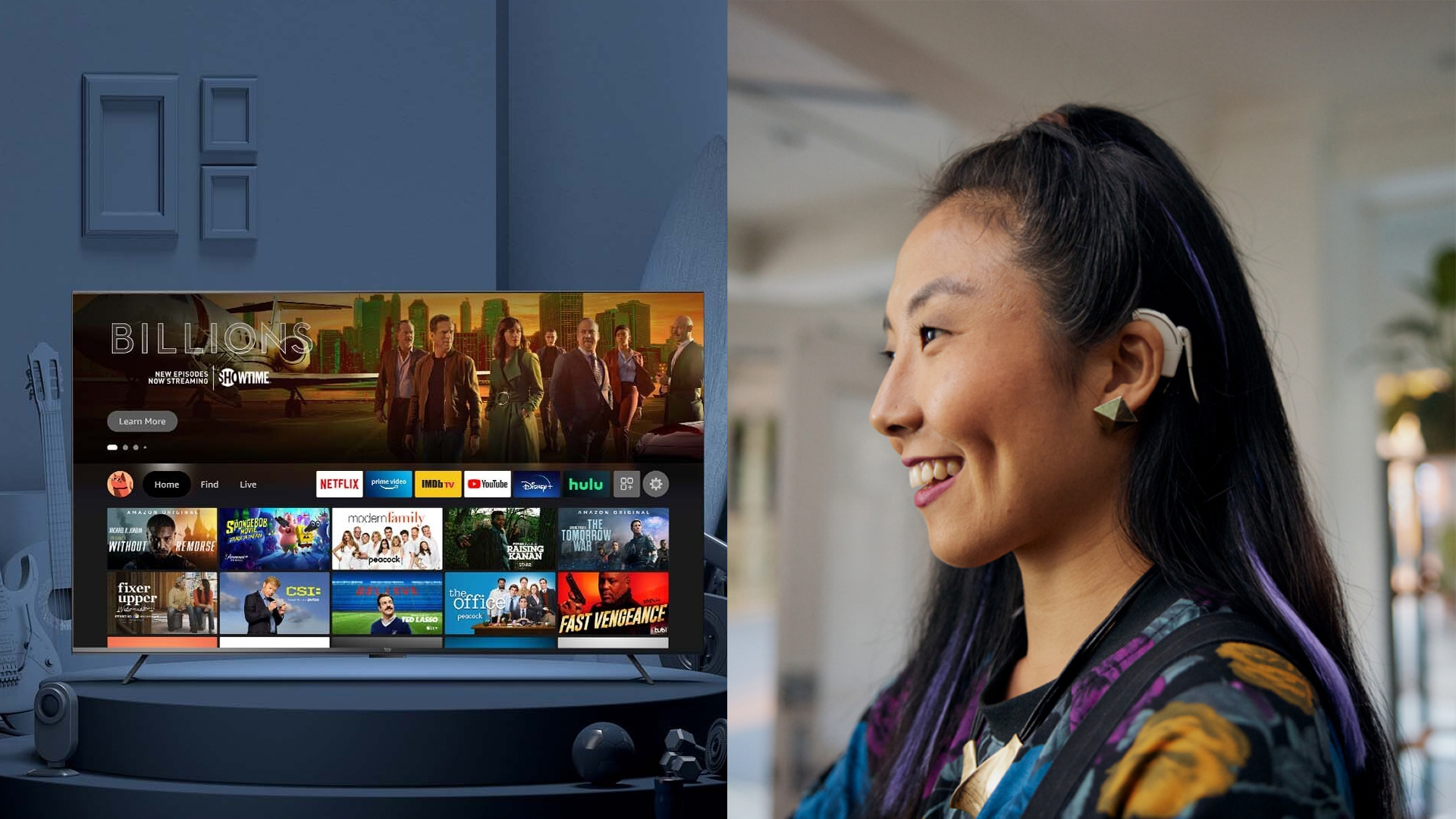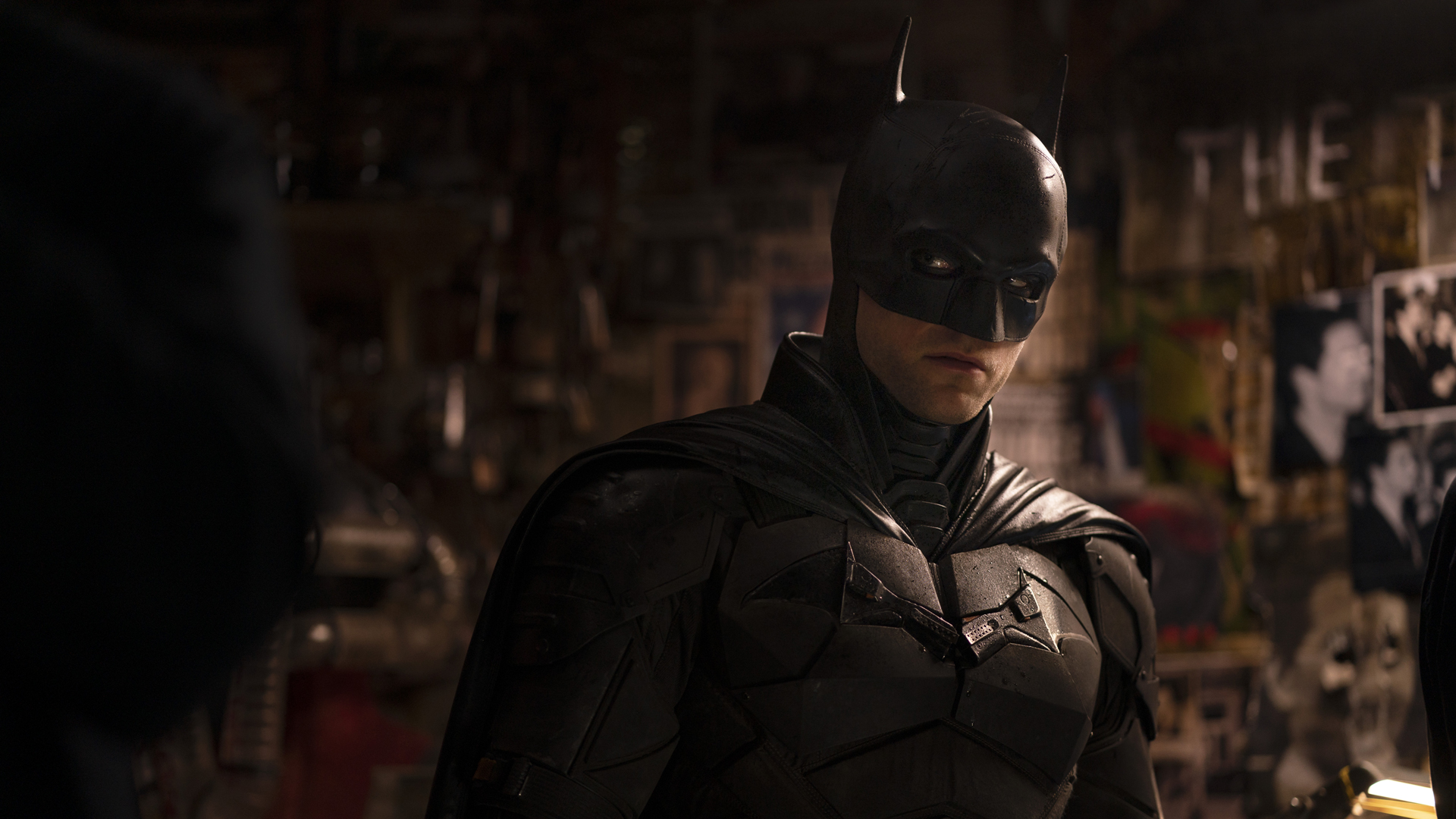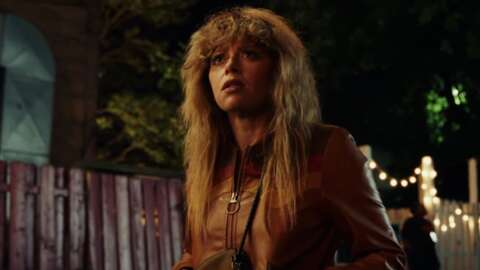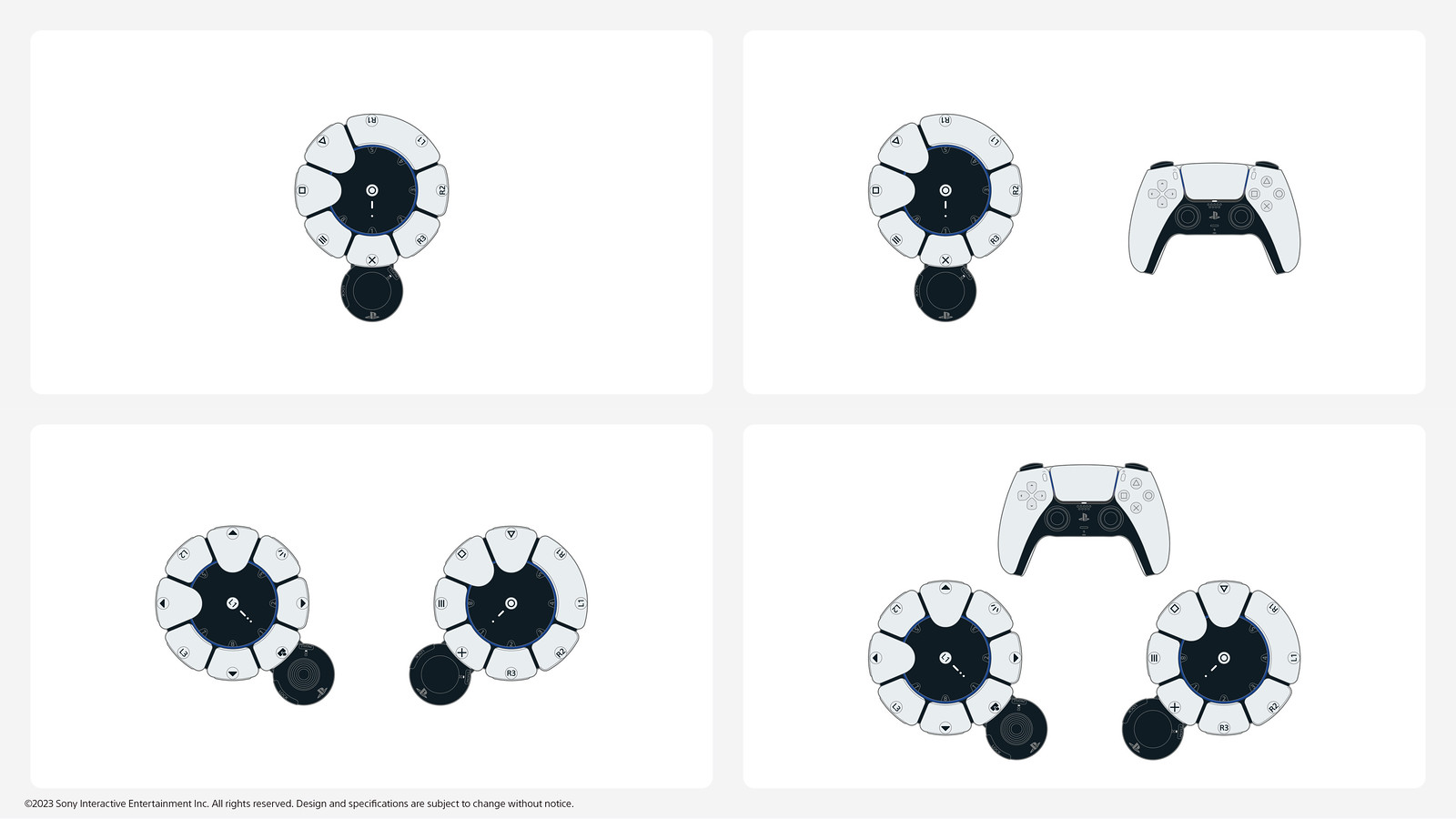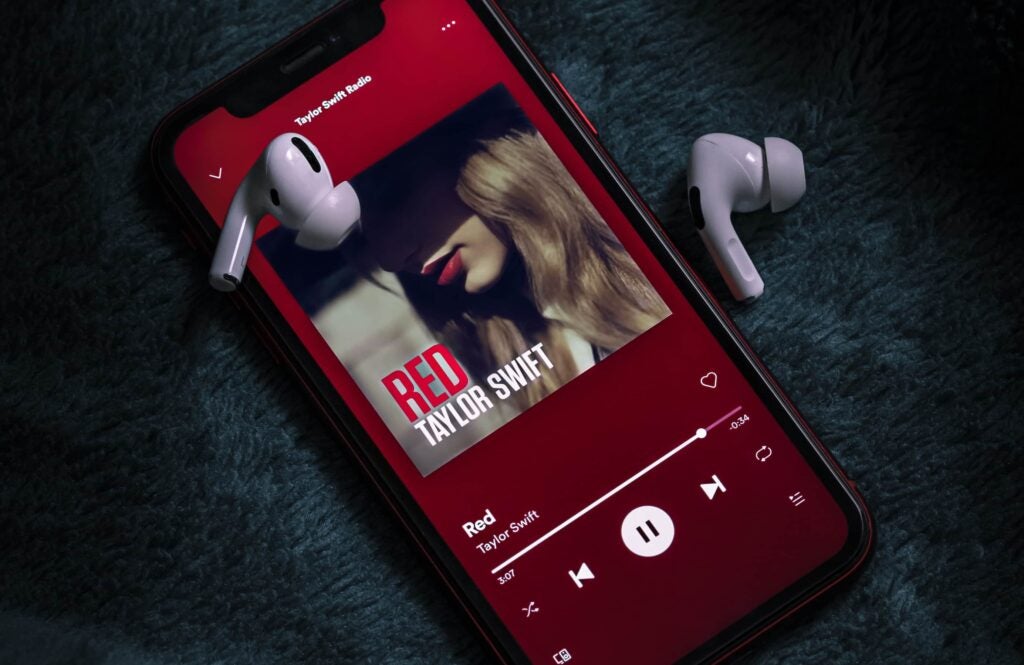Shared posts
Microsoft tries ChatGPT on robots and the results are impressive
Amazon Fire TV devices get an amazing upgrade for hearing implant users
In arguably one of the most genuinely beneficial software updates we’ve seen in a while, Amazon has launched a new feature that enables audio to be streamed directly from its Amazon Fire TV devices to hearing implants.
A collaboration with hearing device maker Cochlear, the feature makes use of the open source Audio Streaming for Hearing Aids (ASHA) protocol and marks the first time that a smart TV device can stream sound directly to a hearing implant processor.
The feature is now available for Fire TV Omni Series, Fire TV Omni QLED Series, Fire TV 4-Series, Fire TV Cube (2nd Gen) and Fire TV Cube (3rd Gen) devices and can work in conjunction with Cochlear Nucleus 8, Nucleus 7, Nucleus Kanso 2 and Baha 6 Max sound processors.
Cochlear already offers direct sound streaming to its Nucleus Sound Processor devices from iPhone or Android phones.
According to Amazon, the new accessibility feature will offer Cochlear users a more comfortable way to watch their favorite movies and TV shows as well as use Alexa, listen to music, and hear navigational sounds.
The new Cochlear feature follows Amazon’s recent move to offer ASHA support on Fire TV Cube (2nd Gen) for Bluetooth hearing aids made by Starkey, the company which manufactures the Audibel, NuEar, MicroTech and Audigy brands.
A blog post and accompanying video featuring hearing-impaired Amazon software engineer Michael Forzano who helped test the feature, highlights just how much of a profound effect the new functionality could have for Cochlear users.
In the posting Forzano, states he didn’t watch TV because he’d miss “40–50% of the words thanks to echoing and poor sound quality.” Using his implant in conjunction with Fire TV appears to have had a real impact in terms of quality of life improvement, with Forzano stating: “I’m really excited for the world that this is going to open up for me”.
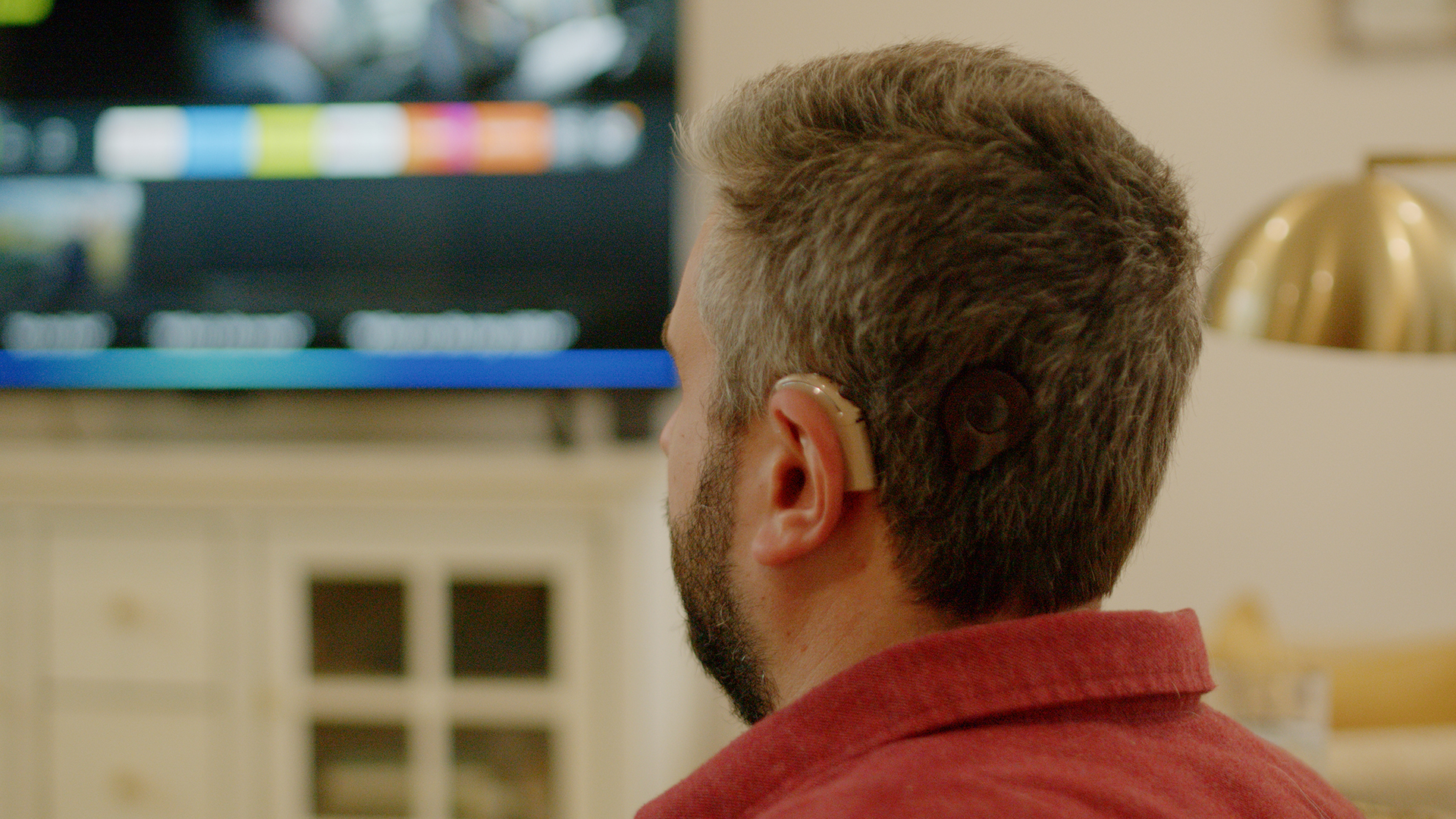
Analysis: Amazon support is an encouraging sign for those affected by hearing loss
With as many as 430 million in the world currently living with some form of hearing impairment according to the World Health Organization, and a recent report warning that one billion young people worldwide could be at risk of hearing damage from listening to headphones at too-loud volumes, it does therefore seem like something of a missed opportunity that more consumer tech manufacturers aren’t tapping into the accessibility benefits these new devices are offering.
Apple has led the way to a certain extent with a host of accessibility features offered to Made for iPhone compatible hearing aids, while the Live Listen feature on AirPods mean they can be used as makeshift hearing devices.
This latest move by Amazon arguably goes a step further with its support for Cochlear implants likely to make a world of difference for users. Fingers crossed today’s news will prompt a flow of tech firms getting on board – how great would it be to see Cochlear audio streaming compatibility for Apple TV 4K (2022) or Chromecast with Google TV… or from any smart TV, really.
Amazon's Zoox is now operating its purpose-built autonomous taxi on public roads
Amazon-owned Zoox has started offering driverless robotaxi rides in California after receiving a testing permit from the DMV (Department of Motor Vehicles), the company announced. Unlike the autonomous vehicles from Cruise and Waymo, Zoox's vehicles are purpose built for driverless taxi rides, so they have no steering wheel or pedals.
On February 11th, shortly after receiving the permit, Zoox conducted the "first run of its employee shuttle service in Foster City, California, marking the first time in history a purpose-built autonomous robotaxi without traditional driving controls carried passengers on open public roads," it wrote in a press release.
To get to that point, the company completed what it called "rigorous" testing with the vehicles on private roads. It also ran its L3 test fleet (hybrid Toyota Highlanders with safety drivers) over a million autonomous miles on data-gathering missions in San Francisco, Las Vegas and Seattle.
Zoox has been developing its unique vehicles since it launched nine years ago, and was acquired by Amazon in a $1.2 billion merger in the summer of 2020. Its robotaxis, introduced later that year, are relatively tiny at 3.63 meters (11.9 feet) long, have passenger bench seats that face each other, four-wheel steering and can drive in either direction. That makes them highly maneuverable, but they can also travel at speeds up to 75 MPH and run 16 hours on a charge thanks to the immense 133kWh battery packs.
Zoox will now offer full-time employees robotaxi rides between its Foster City offices during business hours. "As the company continues to advance its progress and secure additional government clearances, it will expand its service to the general public," the company wrote.
Microsoft’s next-gen Bing uses a ‘much more powerful’ language model than ChatGPT
Microsoft's oft-forgotten search engine is about to get a new lease on life. As expected, the tech giant announced on Tuesday that it is partnering with OpenAI to enhance Bing with the company's AI technology. However, Microsoft also had a surprise up its sleeve: the next release of Bing will feature a new next-generation large language model the company claims is "much more powerful" than ChatGPT and designed specifically to excel at search.
Underpinning the search engine is a new proprietary technology Microsoft is calling the Prometheus Model. Among the benefits of Prometheus are more relevant search results. Microsoft claims the model will also make using Bing safer and allow the company to update search results more quickly.
The new Bing offers a chat function and an expanded search bar that allows you to input up to a thousand characters. In one demo Microsoft showed off during its event, Yusuf Mehdi, the company's consumer chief marketing officer, asked Bing to compare the most influential Mexican artists and their best-known paintings. Bing displayed its response in a new side panel that featured annotations and weblinks. Later, Mehdi asked the search engine to compare three pet vacuums while listing the pros and cons of each model. Mehdi said Bing could also help with questions where there might not be a precise answer. That said, in instances where Bing doesn't know the answer to a query, the search engine will still try to point you to useful information. Microsoft is also adding a button to allow users to share feedback on the search engine's new functionality. "I think of this as Search with your own personal helper," Mehdi said.
The chat feature is there for when you want to use the generative capabilities of OpenAI's technology. For example, say you want to start planning a trip to Hawaii. You can ask Bing to create a five-day itinerary for you. In its response, the search engine will include links to accommodations, flights and things you can do on the islands. The new Bing is available to preview starting today. Microsoft says anyone can visit Bing.com to try a few sample queries and sign up for the company's waitlist. "We’re going to scale the preview to millions in the coming weeks," Microsoft said. A mobile preview is coming soon as well.
A Japanese conveyor-belt restaurant will use AI cameras to combat 'sushi terrorism'
Roumen.ganeffwtf is wrong with kids these days
A viral video trend in Japan has got sushi conveyor-belt restaurants racing to prevent food tampering. One chain, Kura Sushi, said it will use artificial intelligence to look for "suspicious opening and closing of sushi plate covers," Nikkei Asia reported this week.
Kura Sushi plans to start upgrading existing cameras, which are used to track the dishes customers take from conveyor belts to determine their bill, by early March. If the system detects suspicious behavior, it will alert employees.
"We want to deploy our AI-operated cameras to monitor if customers put the sushi they picked up with their hands back on the plates,” a spokesman told CNN. “We are confident we will be able to upgrade the systems we already have in place to deal with these kind of behaviors.”
Many folks in Japan have been outraged by a trend dubbed "sushi terrorism." Videos have shown people carrying out unhygienic acts, such as licking the spoon for a container of green tea powder. Other videos have shown patrons dumping wasabi onto sushi as it passes by on the conveyor belt.
Another video, which apparently has more than 98 million views on Twitter, showed a person licking the top of a soy sauce bottle and the rim of a teacup before putting them back at a branch of the Sushiro chain. They also licked a finger and touched a piece of passing sushi. The clip and the response to it caused the stock of Sushiro's parent company to drop almost five percent.
Sushiro said it replaced all the soy sauce bottles and cleaned every cup at the affected restaurant. Like other conveyor-belt sushi chains, it's enacted other policies like only making food to order to deter tampering and assure hygiene-conscious customers that restaurants are clean.
Kura Sushi has used AI in other ways. In 2020, it emerged that the company was using an app that can grade tuna. At least at the time, Kura Sushi was buying most of its tuna from outside of Japan. The app was said to help it evaluate the quality of the cuts without having to travel in the midst of a pandemic.
The Last of Us developers, HBO creators on building the world around Joel and Ellie
The Last of Us revolves around the story of Joel and Ellie, but their story is a constantly moving one. From one location to the next, the pair learns how many parts of the United States have weathered the Cordyceps outbreak while coming into contact with survivors and their encampments, from those squatting in the ruins of major cities while others have built up new communities in suburban areas or even out in nature.
The world they, and players, explore can be a cruel and unforgiving one, but also a world filled with beauty and light amidst the struggle for survival. Players are met with two distinct but clear examples of how life has transformed in this post-pandemic world early in the adventure of The Last of Us Part I – the Boston Quarantine Zone and Bill’s Town. The dichotomy of these locations demonstrates the human and natural threats around every corner, as well as the bright spots of humanity struggling to survive in this world. With both locations recently featured on The Last of Us on HBO, as well as recently remade in The Last of Us Part I on PlayStation 5 console and available March 28 on PC via Steam and the Epic Games Store, let’s dive into what makes these locations so essential to Joel and Ellie’s journey, and how the HBO adaptation tackled Joel and Ellie’s viewpoint of the world around them.

Cruel world
On the note of viewpoint, when playing The Last of Us, despite wherever the adventure takes you or the characters you meet, the team endeavored to tell this story quite specifically.
“We gave ourselves this rule when we were making it, everything is either seen through Joel’s perspective or Ellie’s perspective, and that’s it, because we want you to spend a lot of time with them moving from space to space in real time and becoming them,” Naughty Dog Co-President Neil Druckmann said.
That perspective feeds into how players are introduced to and informed of The Last of Us’ world and characters. That’s not only true of how The Last of Us’ unforgettable opening communicates its emotional stakes, but also in how players are introduced to the post-outbreak landscape via Joel’s time in the Boston Quarantine Zone, a heavily militarized community overseen by FEDRA, where civilians are just trying to eek by in a harsh world.

“In The Last of Us, when nature takes over society again, we tried to bring out the beauty of natural lighting, and the tone and atmosphere of that,” Naughty Dog Art Director Erick Pangilinan said. “When we show the QZ, we take out all the plants. We take out all the natural life. You won’t see a lot of trees in the QZ, you won’t see a lot of grass. Everything is very sterile, everything is man-made, and you can see the misery of what’s happening in the QZ.”
“It’s very oppressive in the Boston QZ, and we want to express that right away with everything you see. As soon as you walk out onto the street, you see men with guns, fences up everywhere keeping you from walking anywhere other than where the government wants you to be,” Lead Cinematic Animator Bryant Wilson said.

The Naughty Dog team, both originally for The Last of Us’ debut in 2013, and for The Last of Us Part I remake, had to consider how first impressions could immediately communicate the tone and mood of the Boston QZ, and by proxy the way of life so many survivors were facing.
“That first street [in the QZ] does a lot of work creating that world they’re in. The people who are pulled out of their homes, and they’re being forced to take an infected test. When you play through that, you’re given the option to sit and watch it or just walk on by, and it’s not something that we force you to look at, and that’s on purpose,” Wilson said. “It’s a reality of this world.”
“The QZ is man trying to control other people, and how to maintain control over the world and over nature,” Pangilinan said. “A lot of the materials in the QZ are very angular and hard. We like to create that tension of how this oppressive organization is controlling day-to-day life.”

Evoking the tone of this portion of the world, and the difficult realities survivors face under the thumb of FEDRA, is conveyed through every artistic choice, every animation and moment the development team produces to bring the post-pandemic world to life.
“The lighting in that area is very bluish and very overcast. We like to create this atmosphere like you’re in a prison… in the QZ, the people are very frustrated. We wanted to bring out their frustration, their hopelessness,” Pangilinan said. “And you can also see this in the marketplace where, when we tried to design it, we wanted to make sure that the place felt very desperate, very scarce, and people are selling rats and scrap metal because this is what they’ve got, and they’re trading things just to get by.”
The Boston QZ serves an important function in the context of The Last of Us’ story as the players’ introduction to the state of the world in this new era. When considering how to both preserve and refine that experience for The Last of Us Part I, the development team endeavored to bring the world to life with richer detail, but not for the sake of simply adding more.
“The first thing we always do is ask, ‘What was the original intent of this scene,’” like, for example, the QZ marketplace. It’s so easy to just clutter that with goods,” Pangilinan said. “But, in fact, the goal of that scene was to show the scarcity of living in the QZ and how desperate people were. It was important to show what they were eating or what they were selling, and how the whole thing is set up, where everything is just made to pack up and run once they get caught.”
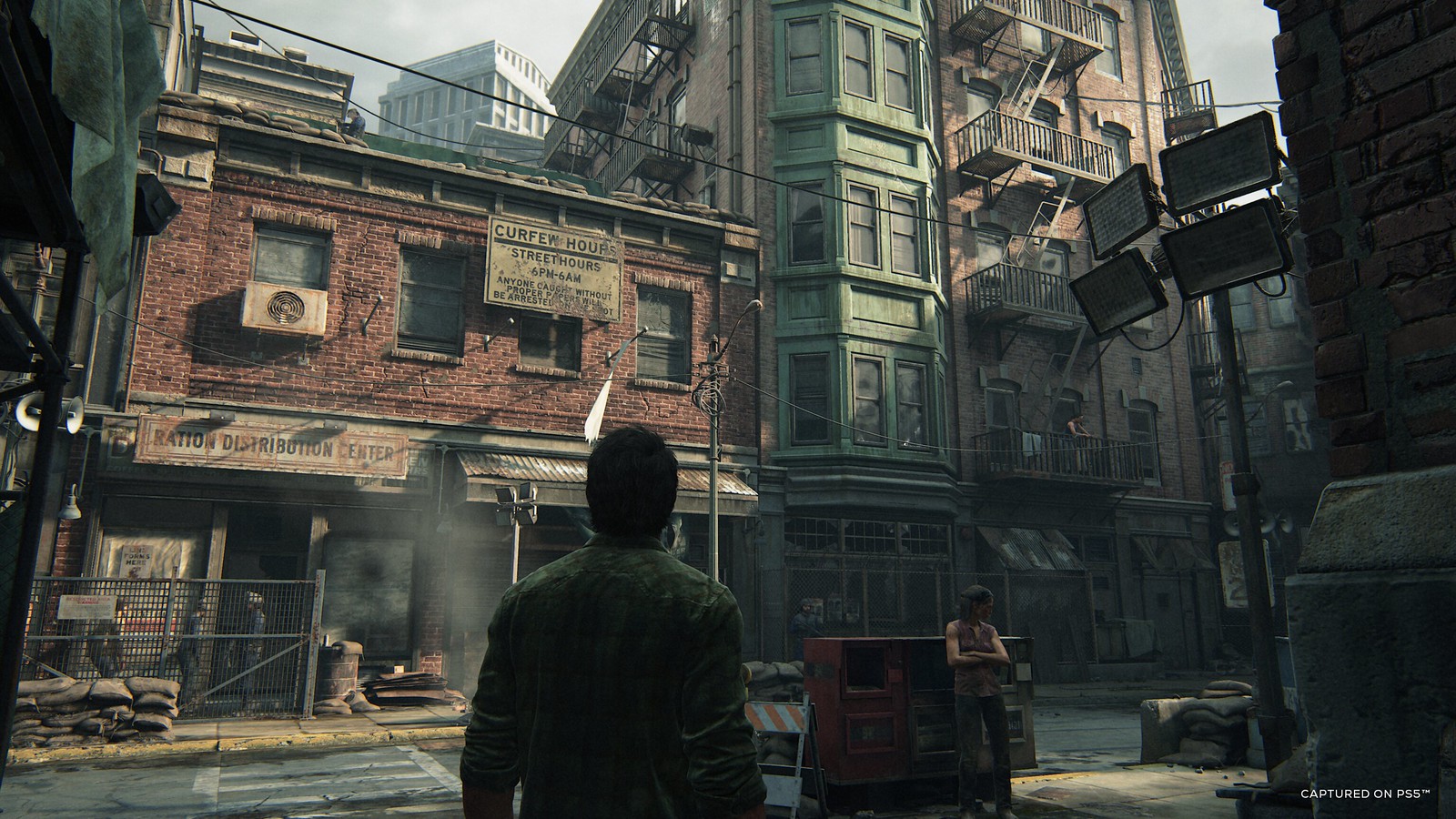
A refinement and improvement of details, rather than a surplus of new ones, helped guide the team in ensuring the remake maintained the tone and emotional honesty of Part I’s original story.
“If there’s any animation that could be improved upon we would, but we didn’t want to add too much to it, mainly because we don’t want to ruin the feeling of the original,” Wilson explained. “Every animation in that sequence has been retouched, redone, reworked and improved, even in ways that may not be noticeable right away.”
HBO’s The Last of Us introduced viewers to the Boston QZ in its premiere, and, as Executive Producer Druckmann explained, offered one of the many opportunities to showcase TLOU’s world from multiple vantage points.
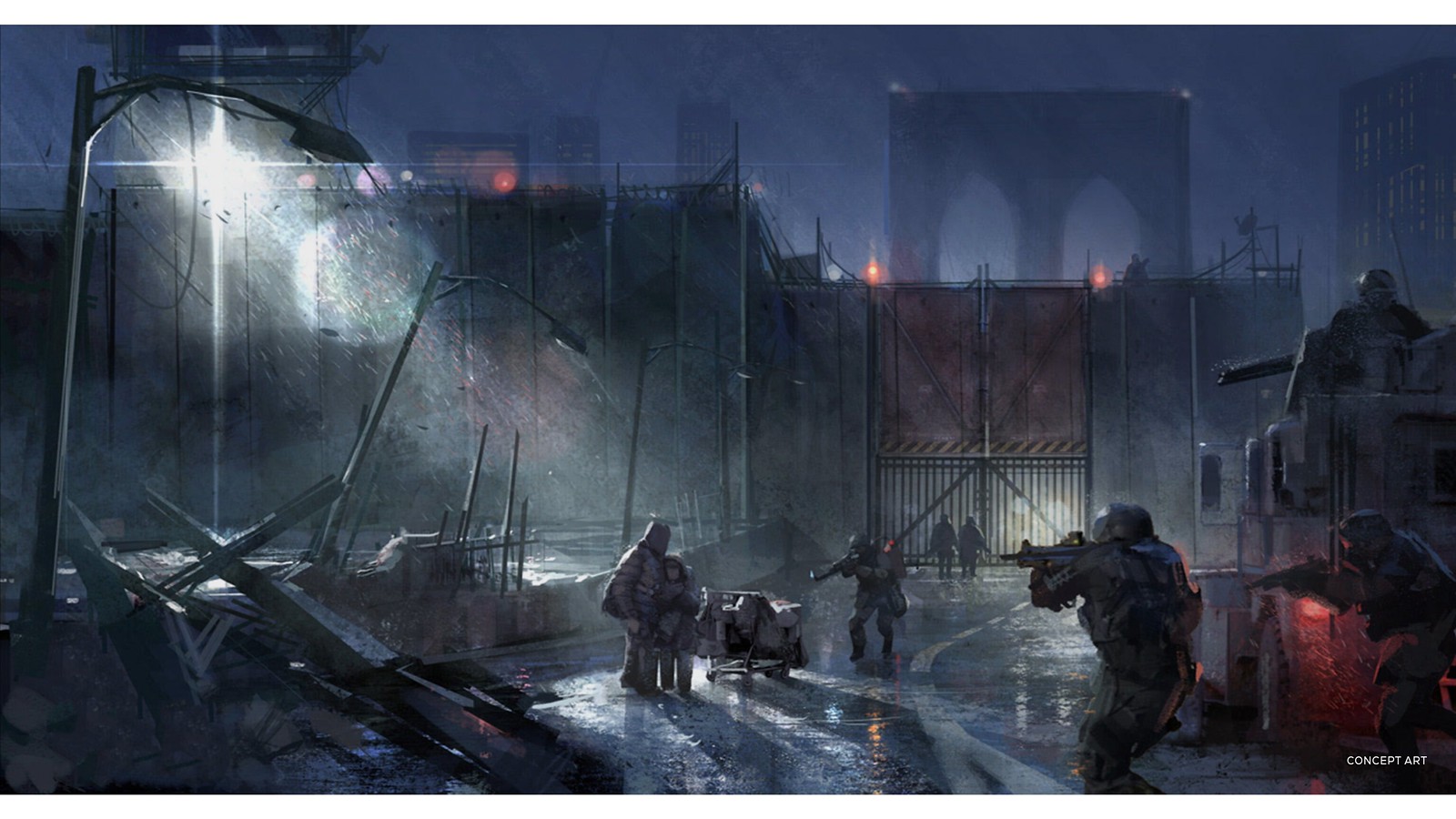
“With the show…we had this opportunity to unplug from our main characters and plug into these other characters,” he said. “You get to see Marlene talking with this new character, Kim, and we get to flesh [Marlene] out some more and see how she deals with the situation of being the leader of the Fireflies in a way that we didn’t get to see in the game. We heard about it offhandedly, but now we get to see the drama of what this character is wrestling with and the push and pull she’s feeling between different parts of her duty.”
“One of my favorite things was being able to walk out certain things about her life and her experiences that were only locked in my imagination,” Merle Dandridge, who plays Marlene both in the game and show, explained. “Obviously, we’d had a ton of conversations, we had imagined, dreamed and thought about who she was and where she had been. But some of these things that the audience is going to get to see are fresh to them in some ways butt still steeped in the truth of who she is and where she came from.”
Even with familiar locations like Marlene and the QZ, the HBO series finds new ground to examine the world of The Last of Us through a new lens. And that idea is particularly true of another environment game fans will be familiar with.
Beauty in the danger
Compared to the sharp-edged buildings, nature-less city streets, and gloomy palette of the QZ, Bill’s Town as seen in The Last of Us Part I is a breath of fresh air, albeit one with danger still lurking in the brush. An abandoned Massachusetts town, the titular Bill has, essentially, created an intricate maze of traps and alarms to keep himself safe in an area largely devoid of human life, but filled with the potential danger of the Infected.
But even with that looming threat, Bill’s Town is an opportunity for players to see the world of The Last of Us come alive – beautiful natural light drenches abandoned homes overgrown with natural flora.
“This is the world that one guy has been curating, and it gives the player a little bit of time to breathe, to look at this beautiful area,” Wilson explained. “This is what freedom looks like now. It’s dangerous, but it has this beauty to it, where the natural world has come back and overtaken it.”

“Bill’s Town has its own isolationist feeling, it’s a person’s castle and it’s his domain. He controls what he lets in and out. And nature is one of those things that can go in and out of it. So we wanted to create Bill’s Town in a warm setting, with the sunset shining through nature and the buildings,” Pangilinan said. “It creates this different aesthetic to contrast where you just came from, the tunnels and the sewer, which is very dark and dangerous.”
But just like with any decision about the artistic ambitions for a given portion of The Last of Us, the world around the player reflects back on the story and characters at the heart of it.
“In Bill’s Town, he lets nature takes it course, but he also has built this into his sort of small QZ. And we wanted to create this mixture of how nature and man balances out,” Pangilinan said. “But Bill’s Town is also representative of Joel. It’s representative of his psyche and his isolationist and paranoid side of his personality. That’s why we represent it with, with walls, with traps, a lot of things that trigger and, and fights back and pushes back so that they can be on their own.
Of course, as those who have watched The Last of Us on HBO’s third episode will know, Bill’s Town is still depicted, in essence, as Bill’s personal fortress, but the way viewers experience it is quite different from the game. Rather than via Joel and Ellie’s perspective, the show flashes back to let us watch Bill (Nick Offerman) and Frank (Murray Bartlett) fall in love and live out their lives. It changes the experience of how fans learn of this corner of the world, but it retains the characters and pathos in a format that better suits its new medium.
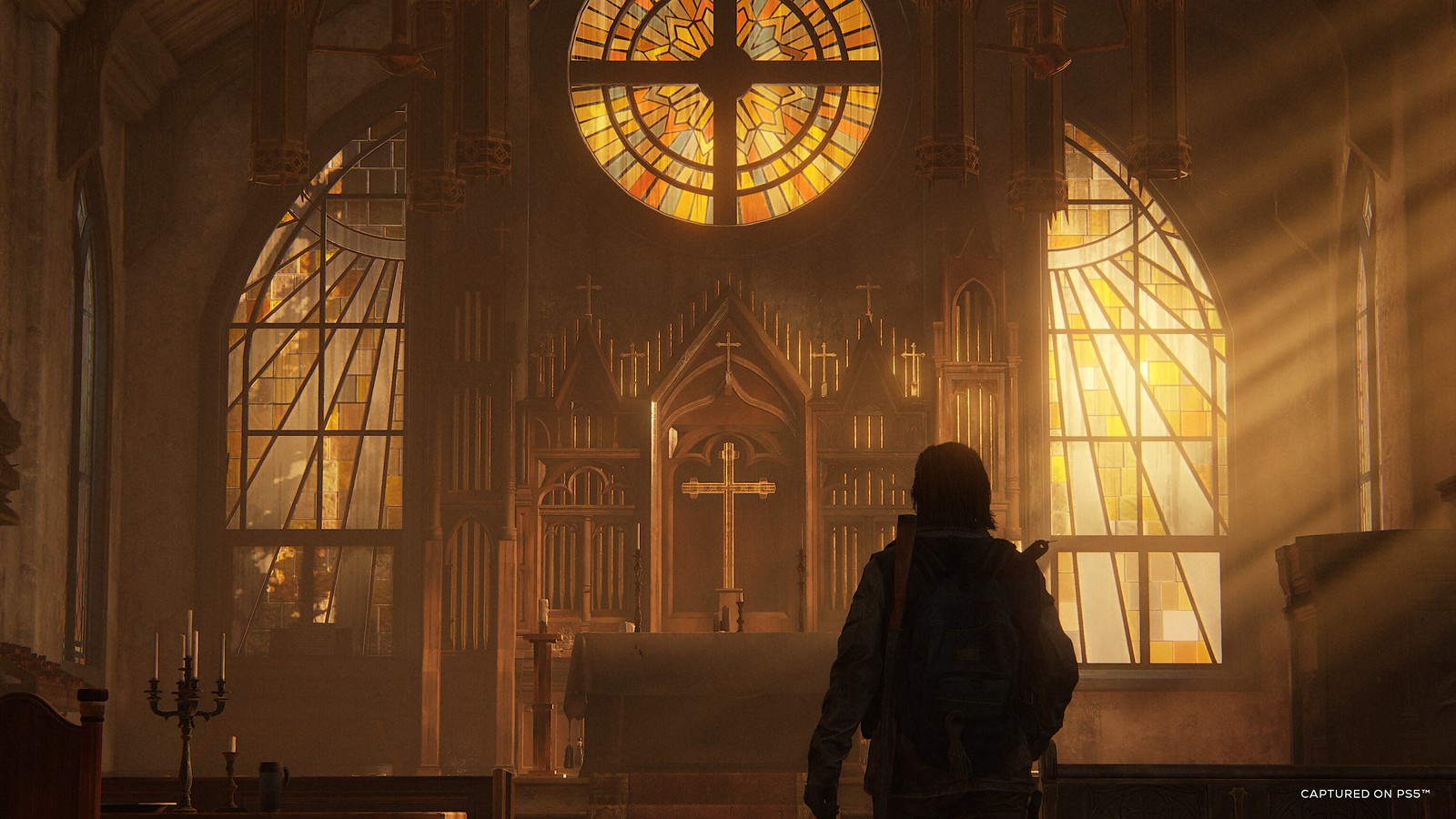
“Bill’s Town is an interesting one because that section was great in the game, but it’s very much a great encounter. You go to this interesting place that is an environmental change from the QZ that you’re in. It’s a small Massachusetts town. You meet a guy who’s funny and cranky and weird, and then there’s gameplay,” Executive Producer Craig Mazin explained of the shift in direction for the show.
“There’s a philosophical argument between these two characters of Bill and Frank that was touched on in the game and is really expanded on in the show, which is, yes, you could survive but to what end,” Druckmann said. “That’s where these two philosophies are presented, where Bill’s position is, ‘That is the end. The end is survival.’ And then Frank is like, ‘No, there’s more to life than this.’ In the game, they have a falling out, and Frank leaves. And in [Craig’s and my] conversations, we thought it could be interesting to show the opposite of that in the show.”
“I thought there’s another way of thinking about this [section of the game and its message], which is that Joel and Ellie are two people that love in different ways,” Mazin explained. “And there’s a good argument to be made that you need both kinds of people, people who love outwardly and then people whose love is protective, both of which can get you into trouble, and that there was an interesting opportunity to just expand the Bill and Frank storyline to tell a story that we didn’t see [in the game].”
The depictions of this portion of The Last of Us diverge, giving fans of the game something entirely new to experience in the episode, while those introduced to Bill and Frank in the show can come to understand their corner of the world in a different way by playing the game. But they’re all rooted in the same desire to bring forth these memorable characters, what their stories mean, and how these relationships impact their lives. And it’s an alternative take that Druckmann welcomed when Mazin presented it, especially as it allowed the show to showcase more perspectives of the world beyond Joel and Ellie while still reverberating through to their story.

“I was terrified when I sent it to Neil because… talk about wandering off the path, and he loved it. I mean he was just like, ‘This is my favorite one so far,’” Mazin said. “Which is a testament to… how much space he created for me to play around and think of some new things.”
“The tragedy of that episode is the note that Bill leaves Joel, which is to say, ‘This is your job. This is what you have to do with Tess,’ and Joel gets that message too late, and that’s when that shift happens,” Druckmann said. He’s like, ‘Well, it was too late for Tess. Maybe it’s not too late for this kid,’ and that’s the mental shift he makes at the end of that episode. Without saying it, that whole Bill and Frank episode reflects back onto them and makes you understand this significant choice that Joel is making at that point.”
And for Druckmann, it was all about adapting the story the Naughty Dog team had worked on in a way that best fit its new medium. In doing so, he hopes it’s an experience that can impact playing The Last of Us for those who have watched it.
“There’s no core [gameplay] loops in a TV show other than viewers sit there, watch and enjoy it. But the drama has to be elevated because of that,” Druckmann explained. So, that allowed us to, in some ways, enrich the world and the characters, and I’ve now heard from a couple of people that have watched the whole show and went back to play the game, and they said the game feels richer now having watched the show.”And whether you’ve already begun to, or are planning to jump back into the game, The Last of Us Part I is now available on PS5, and available for pre-purchase for PC via Steam and the Epic Games Store for release on March 28. For more on The Last of Us and its adaptation to TV, be sure to check out our deep-dive into The Last of Us’ unforgettable opening, and a breakdown of how Naughty Dog brought The Last of Us’ Clickers to life.
The Bad Batch Episode 6 Saves Another Jedi From Order 66
This story contains spoilers for The Bad Batch. If you're not caught up yet, check out our spoiler-free The Bad Batch Season 2 review.
We hope you’ve been practicing your Shyriiwook because The Bad Batch Season 2 just brought back a fan-favorite with some very special powers. Although the series trailer teased the return of Gungi the Wookiee, fans weren’t sure whether our furry friend would appear in the present-day or be another flashback that doomed him to the wall of fallen Jedi.
“Tribe” takes us back to the familiar stomping ground of Kashyyyk. While the Empire tightens its grip on the planet, The Bad Batch puts another important ally in the Wookiee ranks. Following a brief appearance in Star Wars: The Clone Wars, Gungi is back swinging his lightsaber and adding his name to the growing list of Jedi who survived Emperor Palpatine’s Order 66.
What’s Gungi’s Star Wars Story
Introduced in The Clone Wars Season 5’s “The Gathering”, Gungi was one of the Force-sensitive younglings that journeyed to the sacred planet of Ilum in search of kyber crystals to build their lightsabers. Despite his fleeting appearances, Gungi was attacked by pirates, joined Dug Priego’s circus to save Ahsoka Tano, and then took on General Grievous.
The character was part of The Clone Wars’ “Young Jedi” arc, which was briefly considered as another animated spinoff before Disney gained the rights to the franchise in 2012. That never happened, meaning the last we (officially) saw of Gungi, he was in the Jedi Temple hangar when it was bombed and Barriss Offee was arrested for her crimes.
Although Gungi later appeared to Master Yoda in a vision, his proximity to the Jedi Temple and the fact he’d attained the rank of Padawan means he was presumed dead alongside most of the Jedi Order in Order 66. Gungi served under Master Tera Sinube, and given that Sinube’s body was glimpsed in the Fortress Inquisitorius during Obi-Wan Kenobi, things weren’t looking good for Gungi.
But, fast forward to The Bad Batch, when we learn that Gungi is rescued from a group of Vanguard Axis droids, whose leader makes a throwaway comment about someone wanting to purchase Gungi “alive.” Before we can learn who the mysterious buyer is, Clone Force 99 saves Gungi and returns him to his own kind on Kashyyyk.
After defeating the Trandoshan forces of Babwa Venomor (JP Karliak) and being taken in by Yanna (Shelby Young) on Kashyyyk, Gungi is currently safe with his own kind and sure to be an asset to the species' forces as Jedi Wookiee. We leave him with a Return of the Jedi-esque ending where everything seems peaceful… for now.
Will We See Gungi In Live-Action?
There have been complaints that modern Star Wars canon has saved too many Jedi from Order 66, and while it was once just Obi-Wan Kenobi and Yoda, Gungi joins growing ranks like Ahsoka Tano, Caleb Dume, Cal Kestis and more. Much like fans are asking whether Kestis will make the jump from Respawn Entertainment’s Star Wars Jedi video games into live-action, there are questions about when/if Gungi could return.
Gungi is also in the rare group of Jedi Wookiee that includes nixed Legends characters like Tyvokka – who supposedly trained Plo Koon – and Chewbacca’s nephew, Lowbacca. Star Wars expert Pablo Hidalgo confirmed (via Twitter) that George Lucas axed plans for a Jedi Wookiee to appear in Revenge of the Sith, which led to others being rolled back from the Expanded Universe.
Things could be changing, though. Set photos from The Acolyte teased a Wookiee wearing a Jedi tunic, leading to hopes this will be the live-action debut of Burryaga Agaburry from 2021’s The High Republic: Light of the Jedi. With Lucas’ “no Jedi Wookiee” rule revoked, we could see more of Gungi soon. Alongside the question of how Gungi survived Order 66, his return can also clear up what happened to Gungi’s friends like Katooni.
While Gungi seems safe for now, remember that Kashyyyk ends up under the rule of the Empire during the Dark Times and many enslaved Wookiees are sent to work on the Death Star. Gungi isn’t present during the events of Fallen Order on Kashyyyk, and even when the planet is liberated by General Han Solo in 5 ABY, there’s never been a mention of Gungi past this point in the timeline.
With the lifespan of your average Wookiee being 400 standard years, Gungi could appear in everything from The Mandalorian to Damon Lindelof’s post-The Rise of Skywalker project. As The Bad Batch has shown with AZI-3 and Commander Cody, he could just as easily have a part to play further down Omega’s arc. It would be a shame to resign a character as promising as Gungi to the back of canon, and remember what Professor Huyang once said — “Rare you are to the Jedi.”
Pedro Pascal Took an Ambien and Forgot He Was Cast in The Last of Us
Pedro Pascal has admitted that he forgot he landed the lead role of Joel on HBO's The Last of Us because he took an Ambien right before receiving the casting news.
Appearing on The Tonight Show, Pascal revealed that he had a momentary lapse in memory when he was offered The Last of Us job because he had taken an Ambien pill to assist with his sleep after participating in an adrenaline-fuelled, late-night call about the series.
"That was a really strange circumstance. I was actually in London and everyone else was in Los Angeles," Pascal told host Jimmy Fallon. "I got sent these scripts and I was told that 'Craig Mazin wants you to read these scripts. And if you like them, he'd like to talk to you.'"
Pascal explained that he was a fan of the HBO miniseries Chernobyl – which Mazin wrote and executive produced – so he read the first script for The Last of Us and found that it instantly fuelled his desire to meet Mazin and discuss his new series further.
"We talked. We fell in love," he said. "And they were like, 'will you stay up a little bit later?' – at this point, it was getting kind of late in London – 'to talk to Neil Druckmann,' the creator of the video game.
"I stay up for that zoom," he continued. "At that point, it's really late. I've got to get up in the morning. I take an Ambien to go to sleep just in case – they've got my adrenaline kind of going and my hopes up. But I get a call, and I get told that I got the job after I took the Ambien."
The actor said he was "excited," but also "didn't remember" being offered the role, so he woke up the next morning ready to "wait by the phone all day" until he saw some congratulatory messages. "I looked at my phone, I was like, 'Oh yeah, I got the job!'" Pascal joked.
Pascal was cast as Joel, a man who suffered an incalculable loss at the outset of the fungipocalypse. He's tasked with escaping his tyrannically-strict Quarantine Zone to smuggle a young girl, Ellie, across the United States to a medical facility run by a rebel militia called the Fireflies.
"A very traumatic event shapes this man into who he is 20 years later, which is, you know, this dystopian world with fascistic governments and very contagious cordyceps that turns you into an infected monster," Pascal explained before jokingly adding, "It's good times."
The Last of Us debuted its first episode on January 15, and it broke records over at HBO, with more than 4.7 million viewers tuning in for the premiere. The video game adaptation marked HBO's second-best debut in the last decade, only beaten by House of the Dragon.
For those still unsure of how the game-to-TV reimagining is shaping up, check out IGN's 9/10 reviews for the "stunning adaptation" in episode one and the "edge-of-your-seat tension" in episode two, followed by a 10/10 review for the "masterfully told love story" in episode three.
Adele Ankers-Range is a freelance entertainment writer for IGN. Follow her on Twitter.
Microsoft rolls out Teams Premium with OpenAI-powered features
Fresh off the heels of news that Microsoft is making a multibillion-dollar investment into OpenAI, it’s integrating the company’s tech into more of its products and services. Microsoft has announced that Teams Premium is now broadly available. The service features large language models powered by OpenAI’s GPT-3.5, along with other tech geared toward making meetings "more intelligent, personalized and protected,” Microsoft says.
Teams Premium offers AI-generated chapters in PowerPoint Live and “personalized timeline markers for when you leave and join a meeting." Live translations in captions are currently available too. In the coming months, Teams Premium will be able to automatically generate meeting notes with the help of GPT-3.5. Users will have access to AI-generated task and action item suggestions as well. Microsoft will likely expand the Teams Premium AI features over time.
The company previously introduced the Azure OpenAI Service for developers, along with a tool to help beginners build their own apps and a graphic design app that are both powered by OpenAI tech. Word on the street is that Microsoft is building ChatGPT, OpenAI’s astonishingly popular chatbot, into Bing (Google is said to be working on an AI chatbot for Search too.)
Columbia researchers bioprint seamless 3D skin grafts for burn patients
The science of grafting skin has come a long way from the days of scraping it off one part of a patient's body and slapping it back on somewhere else to cover a nasty burn or injury. These days grafts are commonly bioprinted like living inkjets using the patient's cultured cells to seed the growing process, down to the vascularization. The primary shortcoming of these printed grafts is that they can only be produced in flat sheets with open edges. This method "disregard[s] the fully enclosed geometry of human skin," argue a team of researchers from Columbia University. Instead, they've devised a novel means of producing skin in virtually any complex 3D shape they need — from ears and elbows to entire hands printed like a pair of Buffalo Bill's mittens.
The team published their findings, "Engineering edgeless human skin with enhanced biomechanical properties," in the January issue of Scientific Advances. They explained how they engineered, "the skin as a fully enclosed 3D tissue that can be shaped after a body part and seamlessly transplanted as a biological clothing."
“Three-dimensional skin constructs that can be transplanted as ‘biological clothing’ would have many advantages,” Dr. Hasan Erbil Abaci, lead researcher and assistant professor of dermatology at Columbia University, said in a recent press release. “They would dramatically minimize the need for suturing, reduce the length of surgeries, and improve aesthetic outcomes.”
What's more, these uniform grafts have shown superior performance, both mechanically and functionally, than their patchwork alternatives. The Columbia team has dubbed the grafts "wearable edgeless skin constructs" (WESCs). Ok, but can you eat them?
The process of making these skin prosthetics isn't that far off from the existing techniques which result in flat slabs of skin. The transplant site is first scanned with a 3D laser to create a digital facsimile of the structure. That data is worked through a CAD program to generate a hollow wireframe of the appendige and then printed. This serves as the scaffolding on which the patient's cultured cells will grow. It's coated with skin fibroblasts and collagen then covered by an outer layer of keratinocytes (which make up the epidermis) and growth medium to feed the cells as they mature. As with making flat sheets, the entire process requires around three weeks for the cells to fully set up and be ready for transplant.
Initial lab tests with mouse models were encouraging. “It was like putting a pair of shorts on the mice,” Abaci said. “The entire surgery took about 10 minutes.” Don't get too excited, mouse skin is not people skin. It heals differently enough that additional animal studies will be required before we start trying it on humans. Such tests are likely still years away.
New Superman movie release date, Batman and Robin film lead DCU Chapter One plans
Update: here we are, ladies and gentlemen – the new DC Cinematic Universe (DCU) era is upon us.
DC Studios co-heads James Gunn and Peter Safran have unveiled the first details of their 10-year DCU plan. You can read TechRadar's most anticipated DCU movies and TV shows article for what we're looking forward to, too.
And what a lineup it is. To find out exactly what's coming in DCU Chapter One, check out Gunn's Twitter video below:
Here are just a few of our plans. Up, up, and away! #DCStudios #DCU @DCComics pic.twitter.com/8XNDNLUEPqJanuary 31, 2023
"As most of you know, DC has been disconnected in film and television for a long time," co-CEO Gunn said. "It's mine and Peter's job to make sure the DCU is connected in film, television, gaming, and animation."
Elaborating further, Gunn says the DCU will all "work within one story", apart from the likes of Matt Reeves' Bat-Verse, Todd Phillips' Joker movies, and Teen Titans Go! These properties will fall under the "DC Elseworlds" label. Gunn also confirmed that The Flash will reset DC's cinematic slate when it arrives later this year, while DC's three other 2023 movies – Shazam! 2, Blue Beetle, and Aquaman 2 – will all lead into the DCU's next chapter.
But enough talk! If you can't watch the video above, here's the first part (according to Gunn!) of the DCU's next chapter, officially titled "Gods and Monsters", in full:
- Creature Commandos – a new animated series penned by Gunn. The actors who voice characters in this show will also play them in their live-action appearances
- Waller – Viola Davis' Amanda Waller gets a spin-off project where she'll team up with members of Team Peacemaker from the anti-hero's own show
- Superman: Legacy – the "true start" of the DCU. Gunn is midway through writing it, and it'll be released in theaters on July 11, 2025
- Lanterns – a live-action HBO exclusive that tells the tale of iconic Green Lantern duo Hal Jordan and Jordan Stewart. Other Lanterns will also feature
- The Authority – a movie centered on the Marvellous Wildstorm characters. They're a group of superheroes who "think the world is broken" and want to fix it by "any means necessary"
- Paradise Lost – a Game of Thrones-style TV series set on Themyscira, aka Wonder Woman's birthplace
- The Brave and the Bold – a film that introduces the DCU's Batman and Robin – and Robin is Bruce Wayne's son, aka Damian Wayne. Based on Grant Morrison's fan-favorite comic book series and marks the start of the DCU's Bat Family
- Booster Gold – a live-action TV show centered on the DC cult hero. Uses future technology to travel back in time to the present and become a superhero
- Supergirl: Woman of Tomorrow – a live-action film take on Tom King's miniseries, which was released last year
- Swamp Thing – a "dark horror" movie that explores the origins of the iconic monster. It'll tonally sit outside of the rest of the DCU, but still feed into the overall narrative
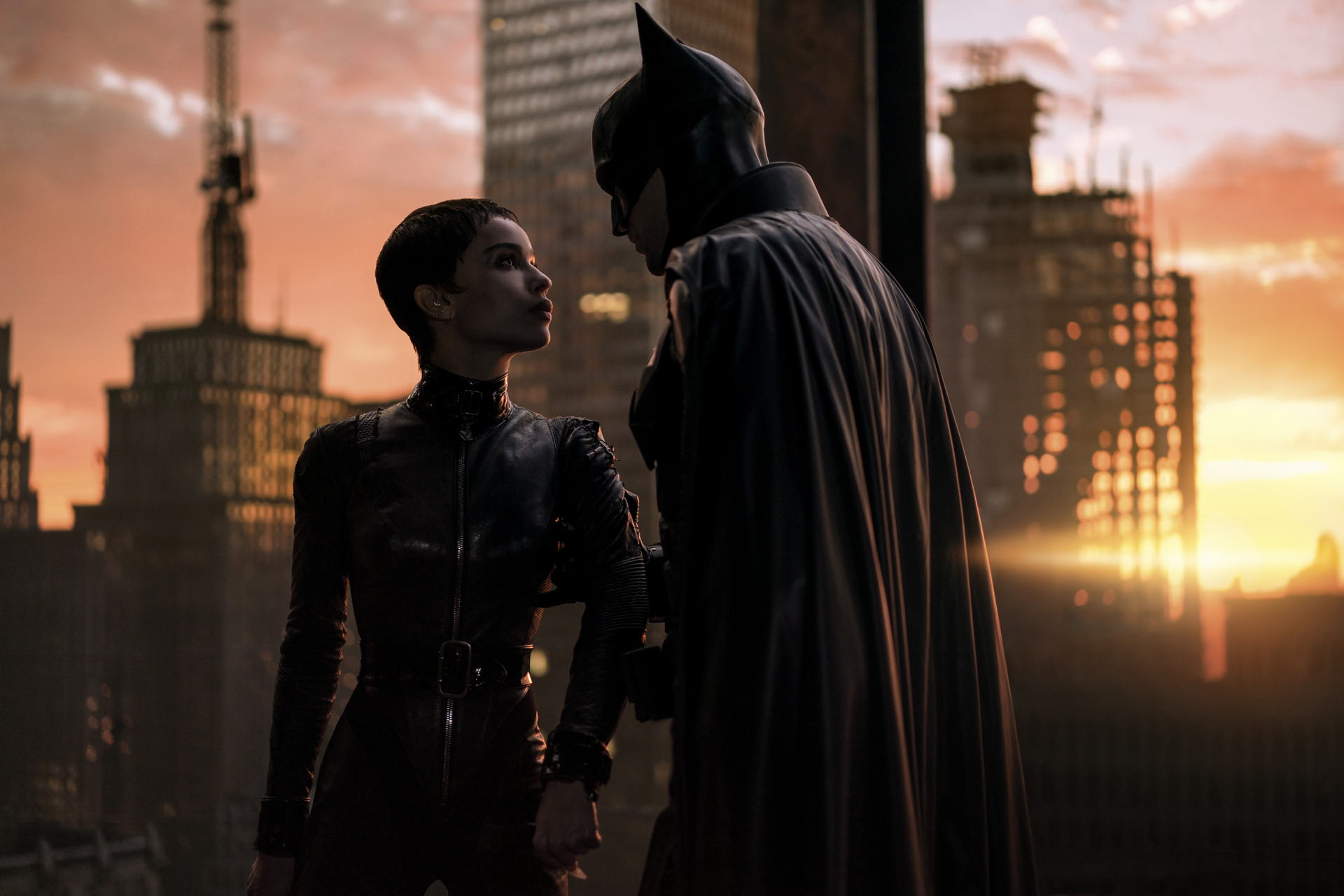
Original story follows.
It's almost time to find out more about the new DCU.
Three months after James Gunn and Peter Safran were appointed co-heads of DC Studios, the duo are set to reveal their 10-year plan for Warner Bros' rebooted DC Extended Universe (DCEU) later today (January 30).
And, frankly, they're cutting it fine. Gunn has consistently stated that he'd share the first official details about the DCU's new blueprint before January 2023 ends – so with one day left before February rolls around, the pair are certainly pushing it.
Finally, though, DC fans will learn more about Gunn and Safran's DCU masterplan. Yesterday, select members of the press were invited to a private presentation concerning the DCU's revival. Per industry insider Grace Randolph, those plans will reportedly be made public at 9am PT / 2pm ET / 5pm GMT on Tuesday, January 31 (that's 3am AEST on Wednesday, February 1 for Australian readers).
So, what can we expect to hear about when the DCU's new lineup is revealed? Here are six things to look out for ahead of the big announcement.
1. Superman returns
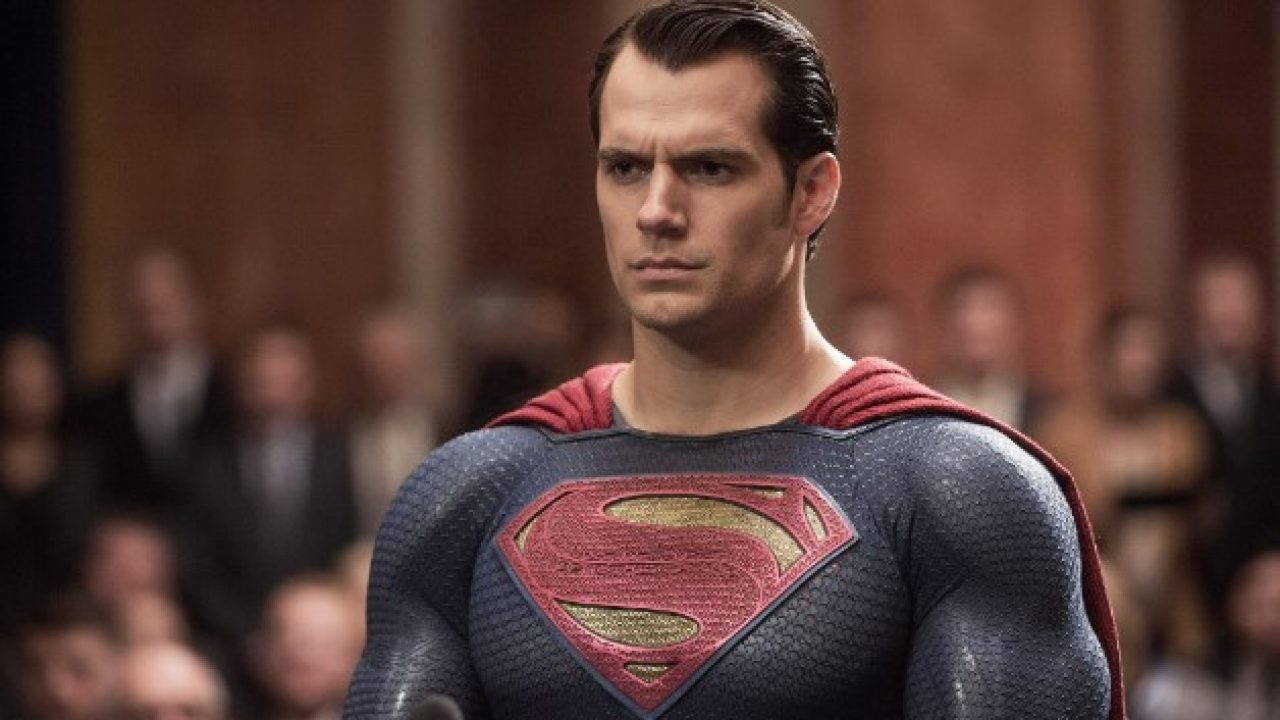
One project we'll definitely hear about is a new Superman movie. In December 2022, Gunn confirmed the next Superman flick would "be focusing on an earlier part" in Clark Kent's life. It won't be a traditional origins story, though.
Unfortunately, that means Henry Cavill won't be back as Superman. Cavill had played the legendary Kryptonian in three DCEU movies – find out which ones in our DCEU movies in order guide – and made a cameo in 2022's Black Adam, which proved to be his final outing as Kal-El.
2. Matt Reeves' Bat-Verse stands alone

Ever since Gunn and Safran's appointment, DC fans have wondered about (and, in some cases, worried about) the future of Matt Reeves' Bat-Verse.
The Batman, which arrived in March 2022, drew critical acclaim for tacking the neo-noir detective aspect of the iconic Caped Crusader (read our review of The Batman for more on what we thought). A sequel film and two HBO Max spin-offs – a series starring Colin Farrell as The Penguin and an Arkham Asylum-based TV show – have since been greenlit.
With Reeves' Bat-Verse preceding Gunn and Safran's hirings, many expected it to be folded into the new-look cinematic universe. However, Reeves told Collider that his Bat-Verse will remain independent of the duo's 10-year plan for the DCU. Todd Phillips' Joker film franchise, whose sequel – Joker: Folie a Deux – arrives in October 2024, is also expected to stay as a standalone entity.
Will we learn more about The Batman 2, or some details about those HBO Max off-shoots as part of today's announcement? We're crossing our batwings that we will.
3. Gone in a flash?
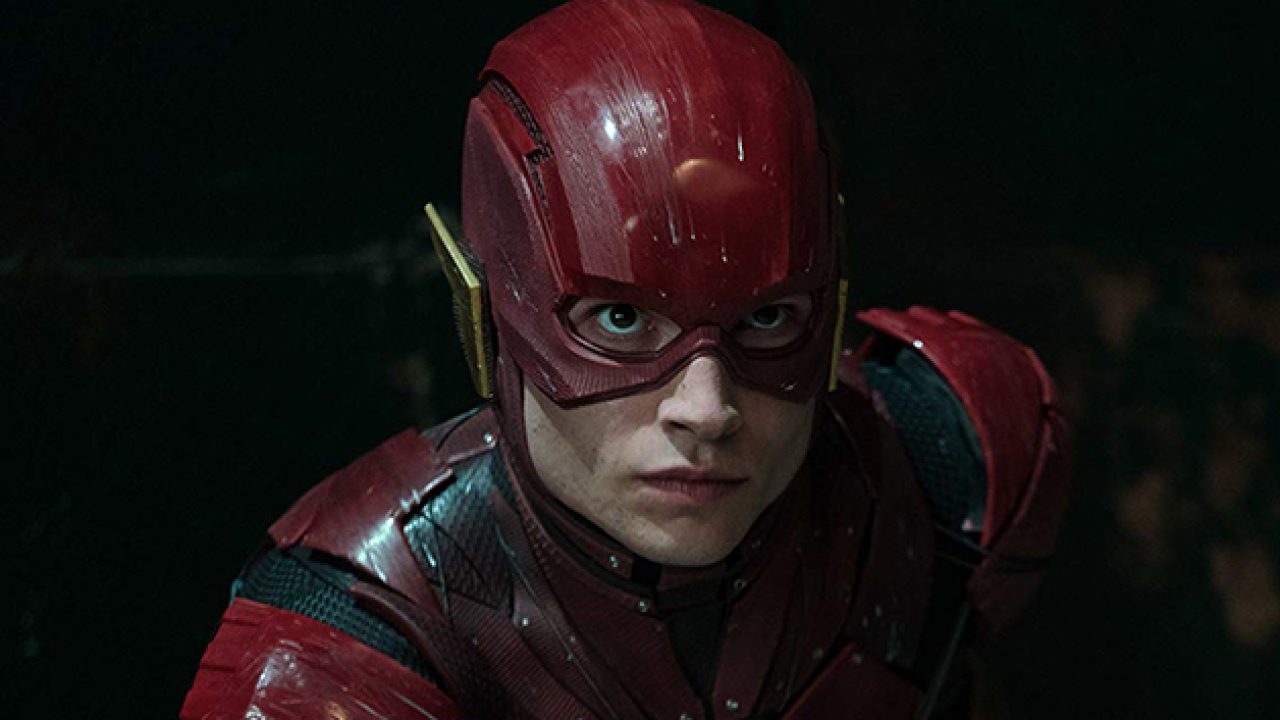
Gunn and Safran's DCU reboot has bigger headaches to solve than Reeves' Bat-Verse.
For one, what do they do about the DCEU movies that are yet to land in theaters? Shazam! Fury of the Gods, Blue Beetle, The Flash, and Aquaman and the Lost Kingdom are all slated to launch in cinemas before 2023 is over. So, will any or all of these characters be incorporated into the new DCU?
Some will and some won't. In December 2022, Shazam! Fury of the Gods director David Sandberg was snapped wearing a hoodie bearing the new DC Studios logo on it. That's led fans to believe that Shazam's film series will be carried over (while you're here, read our Shazam! Fury of the Gods trailer breakdown).
Meanwhile, Aquaman star Jason Momoa alluded to the fact that the ocean-dwelling superhero will feature in the DCU, too (per OneTakeNews). It's unclear what the future holds for Blue Beetle, however, once the Mexican superhero's solo flick is released in August.
As for The Flash, the super speedester's future is also undetermined. It's unlikely that Gunn and Safran will move forward with Ezra Miller's iteration of the character, given the criminal charges leveled against the actor over the last 12 months. It's plausible that The Flash's time-travel and multiversal plot details will form a key part of the DCEU's transition into Gunn and Safran's rebooted universe. We'd be very surprised if the duo retain Miller's services as part of their DCU, though.
4. Wonder no more
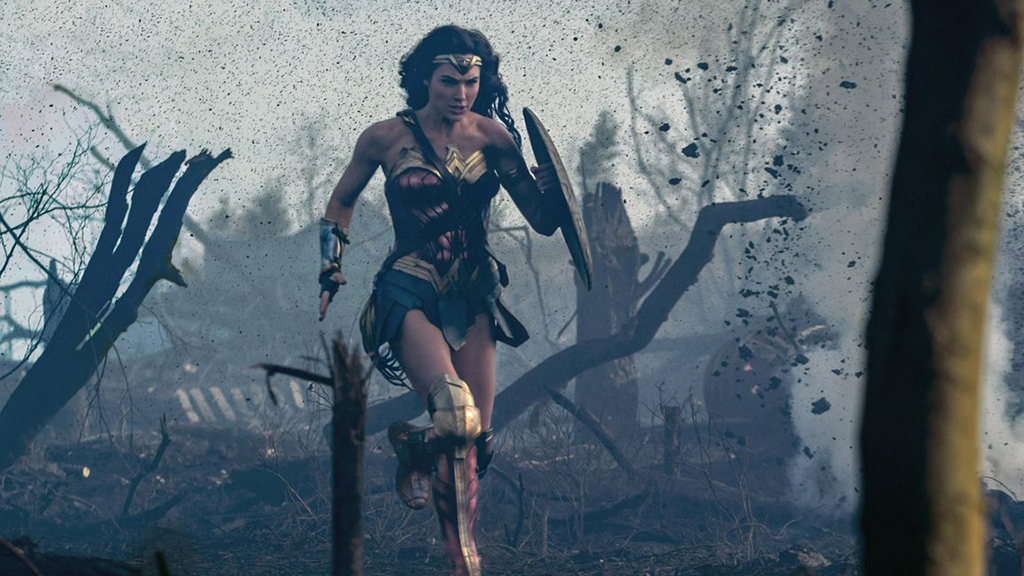
The above characters' fates are yet to be confirmed – hopefully we'll get some details on them later today – but one superhero who won't be part of proceedings is Wonder Woman.
In December 2022, Patty Jenkins – director on Wonder Woman's two DCEU movies – confirmed that Wonder Woman 3 wasn't moving forward at DC Studios. Putting two and two together, it seems like Gal Gadot (who had played Diana Prince in four DCEU films) won't be back as the superpowered Amazonian in the new-look DCU, either.
Of course, we could be surprised by Gunn and Safran – more on other potential surprises later – with a rebooted Wonder Woman film series. Our opinion? Don't expect Diana Prince to be part of their initial 10-year plan.
5. TV show tie-ins

It's not all about movies at DC Studios. As well as those Bat-Verse TV spin-offs, we can expect to hear more about the company's wider TV slate.
As part of our exclusive report about The Dark Knight trilogy remaining on HBO Max, we covered the news that Titans and Doom Patrol – two HBO Max staples – would end after their fourth seasons. Neither show will be part of the DCU, then.
However, there are other series in development that should be part of Gunn and Safran's masterplan. Peacemaker season 2, which was announced in January 2022, is definitely on the way. Dead Boy Detectives, a spin-off from Doom Patrol, is in development, but it's unclear how it'll sit in the wider DCU, if at all.
Meanwhile, Gunn has confirmed that the DCU's slate of movies and TV shows – live-action and animated – will be interconnected. Fan-favorite series, such as Harley Quinn's R-rated animated show, could be merged into Gunn and Safran's DCU. Other DC-owned properties, such as the in-development Green Lantern Corps TV show, plus the second season of The Sandman, might also be folded into the revived DCEU. However, given that the latter is distributed on Netflix, its potential addition to the DCU could make things messy from licensing and contractual perspectives.
6. Surprises galore

All of the above sounds riveting, but we're also expecting Gunn and Safran to drop some shocking announcements as part of DCU Chapter One.
We already know that Constantine 2 (starring Keanu Reeves) is in the early stages of creation. A Ta-Nehisi Coates-developed Superman project, which sits independent of Gunn's young Superman movie, is also in development. We'd love to get some more information on these projects, such as their directors, plot synopses, or further casting news.
There are lots of fascinating characters in DC Comics, though, who could be ripe for live-action and/or animated adaptations. For starters, after conducting a poll on Mastodon, Gunn revealed that Booster Gold was the superhero that fans wanted to see most on the big or small screens.
Elsewhere, industry leaker ViewerAnon has posted two hints about forthcoming DCU projects – one which might tease a Batman and Robin project. Other teases posted by Superman on Film and Stephen Colbert suggest we'll learn about films and shows that nobody expected, one of which is reportedly a "big impending DC movie" that somehow hasn't leaked online pre-reveal. Color us intrigued.
Finally, Randolph has claimed that the new DCU is nothing like Marvel's cinematic juggernaut. Randolph likened it to the mythological tone of Jack Snyder's DC movies, such as Justice League, which might not be music to everyone's ears.
Still, we're excited to find out what's in store for the next decade of the DCU. Warner Bros' DCEU has been drifting for a long time now, and, if it wants to truly rival Marvel on the world stage, it needs an exciting lineup of massive movies and big swing-style TV series. Over to you, Gunn and Safran.
For more DC coverage, read up on how to watch the Batman movies in order. Alternatively, find out which DC movies made it onto our best superhero films list, or the films and TV series that are part of our best HBO Max movies and best HBO Max shows guide.
Titans, Doom Patrol Ending After Current Seasons on HBO Max
Greg Berlanti-produced DC series Titans and Doom Patrol will both end after their current seasons on HBO Max, it was announced today. The news broke across The Hollywood Reporter, Deadline Hollywood, and Variety, with a spokesperson for HBO Max confirming the news to IGN in a statement.
While these will be the final seasons of Titans and Doom Patrol, we are very proud of these series and excited for fans to see their climactic endings. We are grateful to Berlanti Productions and Warner Bros. Television for making such thrilling, action-packed, heartfelt series. We thank Titans showrunner Greg Walker, executive producers Greg Berlanti, Akiva Goldsman, Sarah Schechter, Geoff Johns, Richard Hatem, and the team at Weed Road Pictures. For Doom Patrol, we celebrate showrunner Jeremy Carver and executive producers Greg Berlanti, Sarah Schechter, Geoff Johns, Chris Dingess and Tamara Becher-Wilkinson. For four seasons, fans have fallen in love with the Titans and Doom Patrol, investing in their trials and tribulations, and in their legendary battles saving the world time and time again.
Both are on their fourth seasons that have been divided into two parts, and both also came from the since-shuttered streaming service DC Universe.
The news comes as Warner Bros. Discovery continues to take drastic cost-cutting measures, including removing a wide array of shows from HBO Max and axing the Batgirl movie altogether. DC's film and television slate is also being re-examined at large under the new leadership of James Gunn and Peter Safran.
“I'm immensely proud of our gifted cast, crew, and writing staff and their efforts in bringing to life all forty nine episodes over the last five plus years," Titans executive producer Greg Walker said in a statement. "I couldn't have asked for better partners in Berlanti Productions, Warner Bros. Television, and HBO Max, and from the beginning, Geoff Johns and Akiva Goldsman. I'm incredibly grateful for their unyielding trust throughout this process. Lastly, I have to thank our incredible fans for their continued support, engagement, and the passionate community they've built around our show. We have six episodes left to unleash upon the world that we hope will give our beloved characters the creative closure we all know they deserve.”
“To our wonderfully supportive partners at HBO Max, Warner Bros. Television, Berlanti Productions, and DC Studios, thank you for indulging us these past four seasons," added Doom Patrol executive producer Jeremy Carver. "Also, what were you smoking? To our brilliant cast, indomitable crew, fearless writing staff and, most of all, to our beautiful fans: thank you all the more. You made this a once-in-a-lifetime ride.”
Alex Stedman is a News Editor with IGN, leading entertainment reporting. When she's not writing or editing, you can find her reading fantasy novels or playing Dungeons & Dragons.
The Last of Us: Pedro Pascal Is the 'Ultimate Dad' in Sweet Photo With Ellie and Sarah Actresses
Pedro Pascal is taking his role as "sad dad" Joel Miller in HBO's The Last of Us to heart, taking an adorable photo with his two fictional daughters, Nico Parker and Bella Ramsey.
On Instagram, Ellie actress Bella Ramsey posted a photo of her, Pascal, and Sarah actress Nico Parker hanging out. Pascal commented saying, "My two little big bosses ❤️❤️", with Parker adding, "It’s confirmed that Pedro is now the ultimate dad".
Then, Twitter user @djarinwidow took the photo a step further, by reposting it and adding the caption, “I think the two of you would’ve been good friends. Think you really woulda liked her. I know she woulda liked you.” This is referencing The Last of Us games, when Joel tells Ellie he thinks she and Sarah would have gotten along well if they were able to meet each other.
While the two characters may not get the opportunity to meet, it seems like the two actors playing them are having a blast... And managing to tug at our heartstrings yet again.
The Last of Us on HBO premiered on Sunday, drawing in 4.7 million viewers. In our review of the series premiere, we said, "Episode 1 of HBO’s The Last of Us thrillingly lays the foundations for the emotional torture ready to hurt us along every step of its journey."
For more Last of Us content while you wait for Episode 2 on Sunday, check out how the Last of Us TV series made its opening even more heartbreaking, or our comparison of The Last of Us TV show and video game.
Logan Plant is a freelance writer for IGN covering video game and entertainment news. He has over six years of experience in the gaming industry with bylines at IGN, Nintendo Wire, Switch Player Magazine, and Lifewire. Find him on Twitter @LoganJPlant.
The adorable Loona petbot is ready to roll into even the coldest of hearts
Humans, we’re a sociable bunch. To that end, we’re pre-programmed to develop technology that helps us stay connected with others. Sometimes, though, the connection can be with the technology itself. Enter Loona, the adorable pet robot that will either melt your heart or, at the very least, serve as a loyal smart home companion (or hopefully both).
Loona appears to be the exact halfway point between the adorableness of Anki’s Cozmo and Amazon’s high-end Astro homebot. There’s definitely a focus on younger users here, but kids of “all ages” might find themselves sucked in by her charms. Loona has apparently also been designed to interact well with any analog pets you may already have.
Armed with a 3D camera and edge sensors for navigating your home, Loona also has a regular camera for face detection and object recognition. There are four microphones that provide Loona the ability to locate you as you beckon her and touch sensors so she’ll lean into your head-strokes with eerily biological authenticity. At launch it’ll respond to a slew of verbal commands and gestures, and the company claims new ones will continuously be added. There will also be a graphical programming tool so you can create your own interactions and a community to share them with.
One of the more endearing features is Loona’s expressive personality. Loona’s digital eyes are surprisingly articulate and feel like they are right out of a Disney movie. The company indicated that there could also be the option to add custom expressions and emotions further down the line.
Beyond being a digital pet, Loona can also double as a home security and monitoring system. The benefit being you can direct her around your abode and find where your IRL cat is hiding unlike static pet-cams where you (and I say this from experience) might ruin a weekend away driving back because you haven’t seen your cat appear for two whole days and you’re worried but it turns out she was just sleeping in one spot the entire time. With Loona, not a problem.
Loona was originally launched on Kickstarter securing over three million dollars in backing which, if nothing else, shows that there’s a lot of interest in this category. The robots are now shipping to backers with general availability on track for the end of this month at the company’s website where it will retail for $449. If you’re extra keen you can pick one up now via the IndieGoGo page for $359.
Rian Johnson's Peacock Whodunit Poker Face Gets First Madcap Trailer
Peacock has released the first official trailer for Poker Face, writer-director Rian Johnson's (Knives Out) next big bet on the mystery genre. The 10-epiosde mystery-of-the-week series begins streaming with a four-episode premiere on January 26.
Natasha Lyonne (Russian Doll, Orange Is the New Black) stars as Charlie Cale, who, according to a synopsis "has an extraordinary ability to determine when someone is lying. She hits the road with her Plymouth Barracuda and with every stop encounters a new cast of characters and strange crimes she can’t help but solve." Lyonne will be joined by an impressive group of guest stars that include Adrien Brody, Chloë Sevigny, Ellen Barkin, Hong Chau, Jasmine Aiyana Garvin, Jameela Jamil, Joseph Gordon-Levitt, Judith Light, Nick Nolte, Rhea Perlman, Ron Perlman, S. Epatha Merkerson, Stephanie Hsu, Tim Blake Nelson, and Tim Meadows. Many others are featured in the new trailer below.
As if Poker Face's stellar cast isn't reason enough to give the series a shot, Johnson is also riding high as the Knives Out sequel Glass Onion has quickly become one of Netflix's biggest ever releases. It was recently reported that the whodunit, which was released on December 23, has secured the top spot on the streamer's English-language film charts for the week of December 26 to January 1. Or, to put it another way, the film quickly became Netflix's third most watched film in hours viewed in its first 10 days--racking up 127.25 million hours watched in barely over a week.
Continue Reading at GameSpotFirst History of the World Part 2 Photos Reveal the Mel Brooks Sequel 42 Years in the Making
Hulu has released a first look at History of the World: Part II, its upcoming sequel to Mel Brooks' 1981 feature film which takes a comedic look at historical events.
Entertainment Weekly shared new images of the eight-part comedy series, which is set to premiere on Hulu this spring. The snapshots depict Nick Kroll, Wanda Sykes, and Ike Barinholtz in various scenarios taken from different sketches that will be featured on the show.
A sequel 40 years in the making, Mel Brooks' #HistoryOfTheWorldPart2. Coming soon. pic.twitter.com/3zinLgAf5Q
— Hulu (@hulu) January 4, 2023
The group pose as sports commentators in one photo, while others offer a glimpse at some of the characters they'll be playing. Amongst them is Barinholtz as Russian revolutionary Leon Trotsky, Kroll as cart-wheeler Schmuck Mudman, and Sykes as US congresswoman Shirley Chisholm.
The upcoming series will follow the original movie's anthology structure with each episode spotlighting multiple historical stories. The sketches are expected to include everything from the building of the pyramids to the American Civil War, the Russian Revolution, and much, much more.
History of the World: Part I was released over 40 years ago on June 12, 1981. Unfortunately for History of the World, that was the same day Raiders of the Lost Ark opened in theaters and a week before Superman II, which, combined with poor word of mouth, impacted its box office.
Brooks, who wrote and directed the original movie, is returning for more historical hijinks with the sequel. He is serving as the writer and executive producer of the Hulu series along with Kroll, Sykes, Barinholtz, David Stassen, Kevin Salter, David Greenbaum, and Christie Smith.
Adele Ankers-Range is a freelance entertainment writer for IGN. Follow her on Twitter.
Cover image credit: Hulu via Entertainment Weekly.
Health tech goes down the toilet with Withings' new at-home urine monitor

Withings has announced a new frontier for the health-focused smart home – a connected urine monitor that sits in the toilet bowl.
The Withings U-Scan is described as the first hands-free connected home urine lab, which will negate the need to catch pee in a small receptacle, or on a strip, and offers instant results via the Health Mate app.
Rather than having urine analysed by a doctor (and heaven knows its hard getting an appointment these days), the U-Scan device can offer quick feedback on a number of biomarkers present in the pee. Indeed, there are more than 3,000 metabolites, within our urine, all giving off critical health indicators.
Withings says the device, which is just 90mm in diameter can provide an “immediate snapshot of the body’s balance” with actionable insight.
Most of us only have a urine analysis during a physical or if you go to the docs with a suspected illness, but the company hopes this will make urine analysis more routine. The results shows vitamin C levels, luteinizing hormone levels, keytones, water balance, nitrates, acid-base balance and other markers. If you’re under-hydrated for example, it’ll tell you, and you can correct things.
The system is powered by replaceable cartridges that last three months and can be easily switched out, according to the manufacturer, which is more famous for smart scales and health-focused watches. Analysis is synced via Wi-Fi and U-Scan knows the difference between water from flushes and urine, so won’t be sending you readings with the Ph of your toilet water.
Get the Apple Watch 7 for just £269
Pick up a smartwatch bargain with the Apple Watch 7 at just £279
- Currys
- £90 off RRP
- Now £279
The product will launch in Europe later this year for a few cents short of €500. The UK price has yet to be announced. There’ll be different cartridges for Cycle Scan (designed for women) and Nutri Balance (overall use), with more cartridges to follow in the future.
“The ability of U-Scan to perform daily urine analysis from the home will allow Withings to take its mission to help consumers fully utilize urine data to an entirely new level,” said Mathieu Letombe, Withings CEO.
“It’s one of the most exciting and complex products we have ever announced. We begin this journey with U-Scan Cycle Sync and Nutri Balance and look forward to announcing more cartridges on an ongoing basis as well as medical applications of the technology.”
You might like…
The post Health tech goes down the toilet with Withings' new at-home urine monitor appeared first on Trusted Reviews.
Introducing Project Leonardo for PlayStation 5, a highly customizable accessibility controller kit
Accessibility is an important topic to us at PlayStation, and we want to continue raising the bar to enable every gamer to experience the joy of play. Whether it’s the robust accessibility options in PlayStation Studios games like Santa Monica Studio’s God of War Ragnarök or Naughty Dog’s The Last of Us Part I, or the wide array of features in our PS4 and PS5 console UI, we’re passionate about reducing barriers to play for every gamer.
Today at CES, we announced the next step in our journey to make gaming more accessible: Project Leonardo for PlayStation 5. Developed with key contributions from accessibility experts, community members, and game developers, Project Leonardo is our codename for a new highly customizable controller kit that works “out of the box” to help many players with disabilities play games more easily, more comfortably, and for longer periods.
Through conversations with accessibility experts and incredible organizations like AbleGamers, SpecialEffect and Stack Up, we’ve designed a highly configurable controller that works in tandem with many third-party accessibility accessories and integrates with the PS5 console to open up new ways of gaming. It is built to address common challenges faced by many players with limited motor control, including difficulty holding a controller for long periods, accurately pressing small clusters of buttons or triggers, or positioning thumbs and fingers optimally on a standard controller.

Here are some of the key features:
Highly customizable play experience
Hardware customizations. Project Leonardo for PS5 is a canvas for gamers to craft their own play experience. It includes a robust kit of swappable components, including a variety of analog stick caps and buttons in different shapes and sizes.
Players can use these components to craft a wide array of control layouts. And the distance of the analog stick from the game pad can be adjusted to suit the player’s preference. These components allow players to find a configuration that works for their strength, range of motion, and particular physical needs.
Software customizations. On the PS5 console players have an array of options to tailor their Project Leonardo play experience:
- Button mapping
- The controller’s buttons can be programmed to any supported function and multiple buttons can be mapped to the same function. Conversely, players can map two functions (like “R2” + “L2”) onto the same button.
- Control profiles
- Players can store their programmed button settings as control profiles and easily switch between them by pressing the profile button.
- Up to three control profiles can be stored and accessed by the player from their PS5 console at any time.
Works collaboratively with other devices and accessibility accessories
Project Leonardo can be used as a standalone controller or paired with additional Project Leonardo or DualSense wireless controllers. Up to two Project Leonardo controllers and one DualSense wireless controller can be used together as a single virtual controller, allowing players to mix and match devices to fit their particular gameplay needs, or to play collaboratively with others.
For example, players can augment their DualSense controller with a Project Leonardo controller or use two Project Leonardo controllers on their own. A friend or family member can also assist by helping to control the player’s game character with a DualSense controller or a second Project Leonardo controller. The controllers can be dynamically turned on or off and used in any combination.
Project Leonardo is expandable through four 3.5mm AUX ports to support a variety of external switches and third-party accessibility accessories. This enables users to integrate specialty switches, buttons or analog sticks with the Project Leonardo controller. The external accessories can be dynamically connected or disconnected, and each can be configured to act like any other button.
Flexible, adaptable design
Project Leonardo’s split, symmetric design allows players to reposition the analog sticks as close together or as far apart as they like. The controller lies flat and does not need to be held, so players can lay it on a tabletop or a wheelchair tray. It can be easily secured to AMPS mounts* or tripods, and can be oriented 360 degrees for the most comfortable use. Players can also program the “north” orientation on the analog sticks to match their preferred controller orientation.
Sony Interactive Entertainment designer So Morimoto shares some insights on how his team approached the industrial design of Project Leonardo:
“Project Leonardo is part of the PS5 product family and is based on the same design concept. We were inspired by the idea of all players enjoying the world of PlayStation together. Our team tested over a dozen designs with accessibility experts, looking for approaches that would help address key challenges to effective controller use. We finally settled on a ‘split controller’ design that allows near free-form left/right thumbstick repositionability, can be used without needing to be held, and features very flexible button and stick cap swapping.
“Because players can customize Project Leonardo according to their needs, there is no one ‘right’ form factor. We want to empower them to create their own configurations. The controller can also flexibly accept combinations of accessibility accessories to create a unique aesthetic. I am excited that the design will be completed through collaboration with players rather than presenting them with a single form factor.”
– So Morimoto, Designer, Sony Interactive Entertainment
Looking ahead
Project Leonardo is currently in development and we continue to gather valuable feedback from the community. We’d like to thank all the wonderful organizations and accessibility experts who are supporting us in this effort.
We are also grateful to everyone in the community who has advocated for greater gaming accessibility. You are the reason we do our work and your passion inspires us every day. It’s truly a privilege for us to create products that better serve your needs. We look forward to sharing more in the future, including additional product features and launch timing.
*AMPS is an industry-standard mounting screw pattern for attaching devices to equipment, including accessibility equipment.
NVIDIA RTX 4070 Ti review: 3090 Ti power for $799
NVIDIA's new RTX 40-series GPUs are insanely powerful, but also wildly expensive. That's my big takeaway after reviewing the RTX 4090 and RTX 4080 — sure, they're fast, but who can justify spending over $1,000 on a video card? With the RTX 4070 Ti, which debuted at CES 2023, NVIDIA is offering a slightly more reasonable alternative. Starting at $799, it's still fairly pricey, but at least it's under $1,000. And best of all, it's in many ways better than last year's 3090 Ti, which initially cost a whopping $2,000.
After announcing two RTX 4080 cards a few months ago, NVIDIA surprised us all when it "unlaunched" the $899 12GB model. Given its much lower specs, there were plenty of complaints that it seemed a bit too expensive to be called a 4080. So now we've got the 4070 Ti at $100 less, with the same 7,680 CUDA cores and 12GB of GDDR6X memory that the 4080 was supposed to get. Sometimes, yelling at companies online gets results.
If you've got a small case, the 4070 Ti may also be the first RTX 40-series GPU you can actually use. Both the 4080 and 4090 Ti were triple-slot behemoths — they took up a significant chunk of my fairly roomy mid-tower case – whereas the 4070 Ti just needs two. It also requires far less energy than either of those cards, since it can run with a 700-watt PSU and has a maximum power draw of 285W. (The 4080 requires a 750W PSU, while the demands an 850W unit.) NVIDIA says the 4070 Ti uses around 49 percent less power on average than the 3090 Ti.
Given where it sits alongside the RTX 4080, the 4070 Ti performed exactly as I expected. It clocked in around 20 percent slower in 3DMark's TimeSpy Extreme Benchmark, as well as the Geekbench 4 Compute test. It was also a full 30 fps slower while playing Halo Infinite in 4K with maxed out graphics settings. Now those numbers may sound disappointing, but I was ecstatic to see them. Sure, it's slower, but the 4070 Ti is actually keeping up fairly well with a card that's $400 more expensive (and in many cases, far more). That's something to celebrate!
None |
3DMark TimeSpy Extreme |
Port Royal (Ray Tracing) |
Cyberpunk |
Blender |
NVIDIA RTX 4070 Ti |
10,624 |
14,163/66fps |
4K RT DLSS : 78fps |
7,247 |
AMD Radeon RX 7900 XTX |
12,969 |
14,696/68fps |
4K FSR RT: 57fps |
2,899 |
AMD Radeon RX 7900 XT |
11,688 |
13,247/61fps |
4K FSRT RT: 50fps |
3,516 |
NVIDIA RTX 4080 |
12,879 |
17,780/82fps |
4K DLSS RT: 84fps |
9,310 |
NVIDIA RTX 4090 |
16,464 |
25,405/117.62 fps |
4K DLSS RT: 135fps |
12,335 |
NVIDIA's DLSS 3 upscaling technology also proved to be incredibly useful once again. I reached a smooth 78fps in Cyberpunk2077 while playing in 4K with graphics ray tracing settings set to high. And if you need even more frames, you can always bump down to 1440p with DLSS 3, where I managed to reach 90 fps. The 4070 Ti also blew away the Radeon RX 7900 XT and XTX in Blender's benchmark, though that may have been due to unoptimized drivers on AMD's part.
If you've got a 1,440p monitor running at 120Hz or more, the 4070 Ti is clearly the more sensible purchase in NVIDIA's new family. Halo Infinite hit 165 fps while maxed out in that resolution, and I saw 130 fps in Control was graphics and ray tracing settings cranked up. And, it's worth noting, I didn't encounter any of the odd driver instability that crashed my system multiple times with the Radeon RX 7900 cards. The 4070 Ti was also twice as fast as both of those AMD GPUs in Control while using DLSS 3 and ray tracing in 1440p and 4K.
The ASUS TUF 4070 Ti I reviewed retails for $849, but I ran it at the same stock speeds as other $799 cards. The GPU reached 76C after hours of benchmarking and gaming — that's not as low as the 70C and below temperatures I was seeing on the 4080 and 4090, but those cards also had far more elaborate cooling.
As impressed as I am by the 4070 Ti, every prospective GPU buyer should know that NVIDIA's 30-series GPUs are still great! And while they don't have DLSS 3, they still have excellent DLSS 2 upscaling. Best of all, they're falling in price now that another generation of cards have arrived. You can snag 3060s easily for less than $400, while I've seen 3070s falling below $600 regularly. I'm sure we'll see a 4060 card later this year, but if you're in a rush, don't look down on older hardware.
If anything, the RTX 4070 Ti is awful news for AMD. The Radeon RX 4700 XT and XTX are both faster GPUs in many benchmarks, but once you start enabling ray tracing, they practically crumble. And worst of all, they're $100 and $200 more, respectively. Personally, I'd rather the power of DLSS and the stability of NVIDIA's hardware and software, over the raw speed of those AMD cards.
While I miss the days of “reasonable” video card prices under $500, the 4070 Ti still feels like a dose of sanity. Unless you’re a high-level streamer or pro gamer, there’s little reason to spend four figures on a video card. $799, though? That’s doable. And if anything, it pushes the prices of other hardware down considerably. Even if you don’t buy the 4070 Ti, we should all be thankful it exists.
This wireless 55-inch OLED TV sucks... onto any wall or window
One of the biggest reasons I don't have a wall mount for my TV is because I don't want to deal with the mess of installation. The dust, the drilling, the permanence — all of that gives me stress (I know, I know, I'm more sensitive than most people). So when I heard that the Displace wireless TV can be attached to any wall or surface without a mount, I was very excited. This is a 55-inch 4K OLED screen that uses active-loop vacuum technology to suction itself into place, and the company built handles into the frame to make it easier to hoist. The Displace also has four onboard batteries that eliminate the need for a power cord, and they're hot swappable so you don't have to wait for one to recharge before you can watch your TV again.
Because the prototypes we saw in Vegas were custom designed for CES, the company says details about battery size and charge time aren't available yet. But they did say that they expect users to get a month of runtime if they watch six hours of TV a day. Part of the reason the Displace can do without a power cord is because it doesn't do very heavy processing onboard. It's basically streaming media from a base station that comes with the device and performs the rendering.
My favorite thing about the Displace TV is the ease of setup. I wasn't allowed to try this out myself since the prototypes were fairly precious, so I could only watch as the company's CEO slid his hands into the two slots and lifted the screen. According to Displace, each unit weighs less than 20 pounds, which is impressively light.
The CEO took the TV over to a window, and when the vacuum loops on the back detected it was in contact with a surface, the mechanism whirred to life and began sucking itself onto the glass. After about 8 seconds, it was quiet, which indicated that it had affixed itself and was secure. I was then able to try jiggling the unit and see if I could pry it out of place. I didn't try very hard, since I was afraid of damaging the prototype, but I will say the screen seemed pretty securely attached. I'd say I used the equivalent force of opening a refrigerator door to try and get the suction to budge and it did not.
To dismount the TV, you'd have to press and hold a button on either side, and wait for the vacuum loops to slowly disengage. The company said this mechanism works with any flat surface — even if there is some slight texture like drywall. We tried to put the demo unit up on another wall, but couldn't find a spot wide enough to accommodate the 55-inch panel.
The Displace TV also has a pop-up 4K camera built into the top of the frame, and it doesn't just facilitate high-res video calls. The company's custom software powering the TV also allows for some gesture control, which is the only way to interact with the TV as there isn't a separate remote. For example, holding up your palm during playback will pause your show, while using two hands to mimic a stretching action can zoom in and out of items on the screen. If you have multiple Displace TVs, you can arrange four of them into a square and zoom into the feed from a specific quarter, for example.
There's also a very Minority Report-esque gesture that involves "grabbing" the content from one screen and "throwing" it at another one nearby. And if you point the thumbs up gesture at the camera, it activates a mode that has your content follow you as you walk around your house into different rooms. Since they're all streaming from the same base station, the multiple screens can pick up your content where you left it in a different room.
If you're feeling baller, you can put four Displace TVs together to create a 110-inch 8K TV. In that scenario, the relatively thin bezels here can help minimize disruption when four screens are playing as one. But Displace told Engadget it was also working on future models that could be bezel-less to eliminate the borders altogether. The company also has many plans, including exploring potential partnerships to build in some form of wireless charging, as well as releasing an API to allow third-party developers to create applications for the hardware.
For now, though, I'm already pretty impressed by the concept and want one. At $3,000, though, the Displace TV is fairly pricey. Only 100 units are available for pre-order at the moment, and the company said they'll start shipping in December. I'm anxious to get one to see how well the vacuum system holds up over time — the last thing I want is to wake up to the crash of a $3,000 TV breaking my furniture, hopes and dreams.
Sennheiser's Conversation Clear Plus are hearing aids in disguise
It’s taken longer than we’d hope, but since October, the FDA finally established a framework for new category of hearing aids that don’t need a medical exam, prescription or a fitting by an audiologist. Unsurprisingly we’re seeing the first OTC products being announced at CES. Sennheiser, a mainstay of the consumer audio world, is tossing its proverbial hat into the ring with the Conversation Clear Plus.
As the name suggests, the focus appears to be on dialogue (rather than the holistic hearing experience). Sennheiser says the earbuds will make it easier to understand conversations in noisy environments. This, the company claims, is achieved in a number of ways. At the heart of the device is a Sonova chip. Sonova is behind some of the legacy names in hearing aids such as Phonak and Unitron and it also bought Sennheiser's consumer audio business about 18 months ago.
The Conversation Clear Plus looks a lot like a pair of regular true wireless headphones which will go a long way to removing any stigma or association with conventional hearing aids. Unsurprisingly, they do share a lot of features with regular headphones too. That includes active noise cancellation, even if the application here is more focused on reducing background noise in relation to dialogue.
Like most wireless headphones you’ll have the option to adjust the amount of noise reduction and there’s a companion app for further tuning your hearing experience. Sennheiser says there are three main prestets: Relax, Communication and Streaming. Those are all fairly self explanatory, but the last one marks a key difference between this category and legacy hearing aids — the ability to stream music and audio from your phone. Some hearing aids can do this, but it’s often a sub-optimal experience given that it’s not what they were primarily designed for. Given Sennheiser’s credentials in the headphone world, it seems likely streaming will be comparable to its consumer headphones.
On a more practical note, the Conversation Clear Plus offers a nine hour battery life per charge, with an additional 27 hours/three charges available via the case.
One of the big promises with OTC hearing aids was a significant reduction in cost. Typically a set with a fitting from an audiologist would cost several thousand dollars, the Conversation Clear Plus will retail for $850. The experiences between the two different product categories will obviously be somewhat distinct, given the different form factor, but the modern, gadgety design will appeal to a lot of folks that might otherwise be turned off by the clinical design of classic hearing aids.
The Conversation Clear Plus will be available for pre-order starting Jan 5 and will go on general sale Jan 20.
Finally, a fruit scanner that will tell you if your avocados are ripe
We've all been there. It's late, you're tired from a long day's labor and all you want to do is go home to relax with your loved ones. But you're not at home, are you? No, you're at the supermarket with a hankering for homemade guac and that pile of fresh, treacherous avocados is staring you in the face, mocking you with their inscrutable knobby skins and their likely rockhard insides. Who's got three days to let them sit in a bag after you go full Last Crusade and choose unwisely? That's where OneThird's "freshness scanners" come in.
The company notes that up to 40 percent of the perishable food brought to market annually (~$1 trillion-worth) is eventually discarded before it reaches our kitchen tables. What's more, the current generation of produce scanners can only inform on lab-specific tests (like sugar content and acidity) rather than freshness or potential shelf life. The touch points from OneThird do and, according to the manufacturer, can reduce food waste in these situations by as much as 25 percent on average.
“The astronomical volume of food that goes to waste each year is heartbreaking, particularly since so much is wasted in affluent countries. We’ve worked hard to create technology that helps to address this persistent, global challenge which directly impacts food scarcity,” said Marco Snikkers, CEO and founder of OneThird. “We are proud to have built the first product that accurately and objectively predicts the shelf life of fresh produce. The interest has been overwhelming and we aim to accelerate the deployment of our technology globally.”
Using propriety algorithms to interpret returns from a near-infrared laser, the OneThird devices can determine an avocado's shelf life in real time. The company makes two variants of the system, one for the end user in the produce aisle, and another for the growers in the supply chain.
Amazon Saved Over 10PB of Vital Ukrainian Data Using Snowball Edge SSDs
Guardians of the Galaxy Holiday Special: The 5 Biggest MCU Reveals
Warning: this article contains full spoilers for The Guardians of the Galaxy: Holiday Special! If you haven't already, be sure to check out IGN's review of the special.
Black Panther: Wakanda Forever may have been the final movie in the MCU’s Phase 4, but those lovable A-holes known as the Guardians of the Galaxy just had to get the last word in. The Guardians of the Galaxy Holiday Special catches up with Star-Lord and his team and adds Kevin Bacon to the list of the MCU’s mightiest heroes.
While hardly the most plot-heavy MCU project to come along in Phase 4, the Guardians Holiday Special does reveal some important details about the team’s status quo and what’s coming next as they return to the big screen in 2023. Even James Gunn himself insists this special is required viewing before Guardians of the Galaxy Vol. 3. Let’s break down the five most important reveals.
Star-Lord Has a Sister
Chris Pratt’s Star-Lord is a pretty tragic guy beneath that goofy exterior. He lost his mother at an early age and was raised by space pirates. No sooner did he meet his long-lost father than he discovered Ego was a Celestial hellbent on remaking the universe in his own image. The only family Star-Lord has left is the one he’s built for himself. So it seems only fitting that we learn Peter, like Luke Skywalker before him, had a sister who’s been hiding in plain sight all along.
The reveal that Mantis is also Ego’s child may be a major departure from the comics, but it helps fill in some of the major gaps in her MCU back-story. It explains how she ended up as Ego’s servant, and why he felt compelled to keep her around in the first place. We can infer that, while Mantis wasn’t quite the perfect child Ego had been seeking for all those years, she was powerful enough that Ego didn’t simply want to kill her like all his other abandoned children.
It remains to be seen how much this revelation will factor into the plot of Guardians Vol. 3. But whatever’s coming next, it’s nice to know two of our favorite Guardians have an extra reason to be thankful this holiday season.
Groot Is Almost Grown Up (Again)
It goes without saying that no MCU character has changed more physically over these last 14 years than Groot. He was a full-grown adult in the first Guardians movie, then resurrected as a sapling, then became Baby Groot, then evolved into a moody teenager. Groot isn’t quite back to his full, adult size in the Holiday Special, but he’s getting close.
Does this mean Groot will be back in adult form in Guardians Vol. 3? It’s certainly looking that way. We’ll have to see if he picked up any new abilities along the way. For all we know, Groot will follow the example of his comic book counterpart and finally start speaking in full, intelligible sentences.
The Guardians Have Taken Over Knowhere
MCU fans were first introduced to the space station Knowhere back in the first Guardians movie. This decapitated Celestial head has become a major intergalactic hub, and at one point also served as the home of The Collector’s massive stash. But thanks to Thanos’ attack in Avengers: Infinity War, Knowhere has definitely seen better days.
The Holiday Special reveals two important details about Knowhere in this post-Blip landscape. One, we now have confirmation that The Collector is still alive and wasn’t killed by Thanos (something actor Benicio Del Toro always insisted but was never overtly confirmed). Two, it seems Tivan sold Knowhere to the Guardians rather than try to rebuild his prized collection room. Where the Guardians got the money for such a massive real estate purchase is anyone’s guess. Apparently being three-time galaxy savers is good for the old bank account.
We can definitely expect Knowhere to appear again in the next movie, which hopefully also means a lot more scenes featuring Maria Bakalova’s Cosmo.
The GoBots May Exist in the MCU
Apparently, Drax is carrying a lot of grudges regarding murdered family members. Not only did Thanos slaughter Drax’s wife and child, now we’ve learned that his cousin was killed by a GoBot. This is a random plot point with some potentially major ramifications for the MCU.
Drax’s violent run-in with the cosplayer in the GoBot costume suggests that these Transformers-esque alien robots actually exist in the MCU. That’s an unexpected twist, given that the GoBots don’t even exist in Marvel’s comic book universe. Marvel may have once published Transformers comics, but they've never held the GoBots license at all.
This cameo may just be a case of James Gunn paying nostalgic tribute to a beloved ’80s franchise. But we can’t help but wonder if there’s more going on here. Is this a tease for a larger collaboration between Marvel and Hasbro? Given all the trouble Hasbro has faced in trying to build a cinematic universe around their toy properties, will they turn to Marvel for assistance instead? With any luck, maybe we’ll see the GoBots and ROM the Space Knight joining the MCU in Phase 7.
Gamora Is Still Missing
The Holiday Special doesn’t address the loose end from Avengers: Endgame regarding Gamora, but her absence does confirm that Star-Lord and the gang have yet to track her down. The Gamora we know died at her father’s hand in Infinity War, but the time-displaced 2014 version is still out there somewhere. Her absence is a major reason why Peter Quill is looking so glum.
We can safely assume that the search for Gamora will be a major part of the plot in Guardians Vol. 3, especially since that sequel is shaping up to be the last to feature this current lineup. Even as the team meets Will Poulter’s Adam Warlock and clashes with Chukwudi Iwuji’s High Evolutionary, they’ll also work to bring Gamora home and help her realize she still has a family that cares for her. Like the 2012 version of Loki, Gamora will have to undergo a crash course to catch up on all those years she missed. Along the way, we’ll hopefully learn what she’s been up to since her disappearance in Endgame.
What did you think about these latest MCU plot twists? Are the GoBots really joining the MCU? Let us know what you think in the comments below. And for more on the future of the MCU, brush up on the history of Jonathan Majors' villain Kang the Conqueror and why Secret Wars could easily dwarf even Avengers: Endgame in sheer scope.
Jesse is a mild-mannered staff writer for IGN. Allow him to lend a machete to your intellectual thicket by following @jschedeen on Twitter.
Taylor Swift debacle proves we should never, ever get back together with Ticketmaster

OPINION: By screwing over Swifties, Ticketmaster has picked a fight with the wrong fanbase.
The utter debacle that was the ‘Verified Fan’ pre-sale for the Taylor Swift ‘Eras’ tour – which was supposed to allow qualifying fans the chance to buy before the free-for-all public sale – saw the mighty Ticketmaster site come crashing down.
Fans were stuck in queues for hours, only to find the box office was barren when they eventually reached the front. Some who’d received Verified codes were unable to access the queue at all.
when you're trying to get taylor swift tix but ticketmaster keeps crashing pic.twitter.com/FOSdMrIP2Y
— Megan Plevy (@mplevz) November 15, 2022
For those who eventually saw tickets were available, the dynamic pricing policy saw fans reportedly quoted prices of up to $700 for tickets that were originally priced between $200-$300. This ‘Dynamic Pricing’ initiative was supposed to discourage the ticket scalpers reselling for exorbitant prices by raising prices in line with demand. It failed. Those tickets are now selling for thousands instead of hundreds on the secondary market. Good work, Ticketmaster. Is it any surprise the Bad Blood is boiling over?
Now Ticketmaster has cancelled Friday’s public sale “due to extraordinarily high demands on ticketing systems and insufficient remaining ticket inventory to meet that demand.”
It’s a mess. But it’s also an opportunity. An opportunity to truly say “no more”, and end Ticketmaster’s reign of terror over our favourite sports games, music concerts and theatre shows.
Get the AirPods Pro 2 for less ahead of Black Friday
Amazon has chopped £10 off the excellent ANC-toting earbuds, bringing the price down from the original £249 to £239.
- Amazon
- Save £10
- Now £239
Fans won’t Shake It Off
Ticketmaster is used to copping flack from music fans, for its sky-high fees, abject failures to combat the bots sniping tickets from real fans, and more recently for its dynamic pricing initiative. It’s a truly disgusting display of unfettered capitalism, which turns the universal joy of live music into a first class-only experience for the most affluent.
But this feels different. This time Ticketmaster has thoroughly annoyed arguably the most passionate fanbase in music. Of course, there’ll never be enough tickets for everyone, but the sense of injustice and anger felt by Taylor Swift fans won’t be forgotten.
The documentary on the takedown of Ticketmaster by rabid Taylor Swift fans is going to be so good.
— Alex Goldschmidt (parody) (@alexandergold) November 17, 2022
The momentum is growing to demand permanent action against Ticketmaster. The cancelling of Friday’s public sale shows the company is on the ropes and daren’t risk another problem. There’s a huge swell of anti-Ticketmaster sentiment out there, it’s being reported on by all the major news organisations. Fans, artists, and politicians can all do their bit.
Firstly, it’d help if Taylor herself spoke out on this. It shouldn’t rest on her shoulders, but if there’s anyone in the music industry with the power to ensure a new era of fairness for their fanbase, it’s her. She’s taken on tech before, ensuring artists were paid royalties for free Apple Music trials.
But she’s yet to comment on this Ticketmaster debacle – few artists ever do. Some fans are justifiably upset with her for the perception she must have opted into the dynamic pricing scam in the first place. That hasn’t been established, but it’s far more difficult for fans to say no to Ticketmaster than big name artists. The service became a monopoly after the Live Nation merger in 2009 and now there’s no other game in town for big events. They really are the ticket masters, but artists can and should do their part to protect loyal fans.
I’m sorry but…having dynamic pricing for tickets IS 100% on Taylor Swift. I don’t care if people will get mad at me for this. She knows the demand is insane for tickets and it literally GIVES Ticketmaster the opportunity to price gouge us. #TheErasTour
— C(@yelhsagraveyard) November 15, 2022
It’s easy to say fans should just boycott the biggest events until something is done about the company’s unfair, exploitative, and damn right greedy policies. But if the biggest fans don’t buy the tickets, someone else will. Why should the most ardent supporters of these bands and artists miss out?
It’s an incredibly tough pill to swallow, but I’ve accepted I’ll just never buy tickets to a big concert again after Ticketmaster’s imposition of dynamic pricing. I won’t be able to afford it, and I won’t pay above face value out of FOMO.
It’s also up to the politicians to act in the interest of the people. High profile democratic congresswoman Alexandria Ocasio Cortez (aka AOC) has called for Ticketmaster to be broken-up. There’s never been a better time to call your MP or representatives’ office and demand they take on the Ticketmaster problem.
Tennessee Attorney General is launching an investigation into Ticketmaster following their disastrous presale of Taylor Swift’s tour.
— Pop Base (@PopBase) November 17, 2022
It will investigate whether Ticketmaster delivered on its promise to customers and could grant a court order to “make the company do better.” pic.twitter.com/QUMTiAvPDq
Taylor Swift’s tour sale is a perfect example of how the Live Nation/Ticketmaster merger harms consumers by creating a near-monopoly. I’ve long urged DOJ to investigate the state of competition in the ticketing industry. Consumers deserve better than this anti-hero behavior.
— Richard Blumenthal (@SenBlumenthal) November 16, 2022
Daily reminder that Ticketmaster is a monopoly, it’s merger with LiveNation should never have been approved, and they need to be reigned in.
— Alexandria Ocasio-Cortez (@AOC) November 15, 2022
Break them up.
Money for nothing
All of this is even more galling when you realise there’s never been a company that reaps such incredible rewards from doing so little. If there is, I can’t think of it. Yet its share of the spoils is unfathomably high, due to the ticketing monopoly it has been allowed to create over the years.
My wife and I always joke that we buy three tickets for every event, one for me, one for her, and one for Ticketmaster. Check the fees next time you checkout. For every two tickets you buy, the fees amount to a third. More Perfect Union, which advocates for breaking up Ticketmaster, says the fees sometimes amount to 78% of the price of the ticket.
It’s just too much. It has to stop. You don’t mess with Swifties; they’ll remember it all too well.
You might like…
The post Taylor Swift debacle proves we should never, ever get back together with Ticketmaster appeared first on Trusted Reviews.
Twitter hit with mass resignations after Elon Musk's ‘hardcore’ ultimatum
Elon Musk is now facing a new crisis at Twitter as a wave of employees seemed to reject his ultimatum of an “extremely hardcore” Twitter 2.0 or leave the company. Hours after a deadline for workers to check “yes” on a Google form accepting “long hours at high intensity, it seems a large number of employees have rejected Musk’s vision.
Exactly how many employees opted for severance over remaining at Twitter isn’t yet clear. The New York Timesreported the number was in the “hundreds,” while other early reports suggest the number could be much higher. The departures come after Musk already cut 50 percent of Twitter’s jobs in mass layoffs.
On Twitter, dozens of Twitter employees who had survived the initial round of layoffs tweeted farewell messages. One employee tweeted a video of a group of workers inside Twitter’s office counting down to the 5pm ET deadline on Musk’s ultimatum. “We’re all about to get fired,” he said.
It’s been a ride pic.twitter.com/0VDf5hn2UA
— Matt Miller (@brainiaq2000) November 17, 2022
Others tweeted messages alluding to Musk’s policies. In his Wednesday morning message, Musk had said that “only exceptional performance will constitute a passing grade.”
I may be #exceptional 💁🏼♀️, but gosh darn it, I’m just not #hardcore 🧟♀️#lovewhereyouworkedpic.twitter.com/7kLjpmSSzF
— Cheesehead in SF 🧀 (@andreachorst) November 17, 2022
That 5p release from the strict meritocracy #lovewhereyouworkedpic.twitter.com/OEE8zNogI3
— Joan De Jesús (@JoanSDeJesus) November 17, 2022
As the deadline approached, Musk reportedly grew concerned about how many remaining employees could leave the company. In a new memo, he appeared to walk back some of his earlier comments banning all remote work, though he still said he would fire managers if remote workers on their teams weren’t performing.
But it seems the concession wasn’t enough for many at Twitter Platformer’s Zoe Schiffer reported Thursday that Musk and his lieutenants were struggling to figure out just how many employees had declined to check the “yes” box on his Google form, and that Twitter would be closing down access to its offices for a few days as an extra precaution.
The departures raise new questions about whether the remaining Twitter engineers will be able to reliably keep the service up and running. Current and former employees are already speculating that the latest exodus could further put Twitter’s ability to function at risk, especially with the start of the World Cup a few days away.
Twitter no longer has communications staff, but Musk so far hasn't publicly commented on the resignations.
Chinese GPU Dev Starts Global Sales of $245 RTX 3060 Ti Rival
Kevin Conroy, Voice of Batman In Animated Series and Arkham Games, Dies Aged 66
Kevin Conroy, the voice of Batman in the 1990s Animated Series, the Arkham series of video games, and more, has died aged 66.
Announced on Facebook by Animated Series co-star Diane Pershing (who played Poison Ivy) and confirmed by Warner Bros. Discovery, Conroy died on November 10 following "a short battle with cancer".
"He's been ill for a while but he really put in a lot of time at the cons, to the joy of all of his fans," said Pershing in the post. "He will be sorely missed not just by the cast of the series but by his legion of fans all over the world."
I don’t have the words. Not today. My heart is broken. There will never be another. He IS #Batman. #RIPLEGEND pic.twitter.com/hJcUVEVeWm
— tara strong (@tarastrong) November 11, 2022
Conroy also played Batman in The Killing Joke animated special and the Multiversus video game, and played Thomas Wayne in upcoming series Batman: Caped Crusader, though it's unclear if he will still feature in the role following his death.
Other co-stars shared their love for Conroy in a Warner Bros. Discovery press release, with Mark Hamill (who has played The Joker in several productions) saying simply that "Kevin was perfection".
He continued: "He was one of my favourite people on the planet, and I loved him like a brother. He truly cared for the people around him - his decency shone through everything he did. Every time I saw him or spoke with him, my spirits were elevated."
In the documentary I Know That Voice, Kevin Conroy tells this unforgettable story about working at a food relief station in Manhattan in the days after 9/11. It’s one of my favorite stories he told about the power of his talents. Rest In Peace Mr. Conroy pic.twitter.com/CVb6vLQlEb
— Henry Gilbert (@hEnereyG) November 11, 2022
Casting and dialogue director Andrea Romano also shared her appreciation for Conroy following his death. "Kevin was far more than an actor whom I had the pleasure of casting and directing," she said. "He was a dear friend for 30 plus years whose kindness and generous spirit knew no boundaries. Kevin's warm heart, delightfully deep laugh, and pure love of life will be with me forever."
Several other fans and friends of Conroy took to social media to voice their love of the actor, including actress Tara Strong (above), podcaster Henry Gilbert (above), Injustice co-creator Ed Boon, games industry veteran Geoff Keighley, and many more.
Image Credit: Pacific Press/Getty Images
Ryan Dinsdale is an IGN freelancer. He'll talk about The Witcher all day.
Raspberry Pi Drives Holographic Anime Virtual Assistant
Audio-Technica announces ATH-TWX9 auto-sterilising earbuds

Audio-Technica has announced the ATH-TWX9, a set of true wireless earbuds with a unique auto-sterilising feature.
The ATH-TWX9 are premium in-ear headphones with five ANC presets, six hours of continuous playback, a case providing up to 18.5 hours of extended use and wireless charging, and what Audio-Technica describes as an “IPX4-equivalent splashproof rating”.
That’s not what sets the ATH-TWX9 apart from the crowd, however. That would be the deep-UV sterilisation system built directly into the case. Whenever you place the earbuds in the case, a 70-second sterilisation process begins, with mirrors employed to distribute the light evenly.
Audio-Technica claims that the sterilisation process eliminates bacteria and viruses from the surface of the earbuds.
In terms of audio output, the ATH-TWX9 features 5.8mm drivers and supports Sony’s 360 Reality Audio for a realistic 3D sound stage. Supported codecs include Qualcomm’s aptX Adaptive audio.

Call quality is boosted by Sidetone circuitry that lets you hear your own voice in the headphones, which is compatible with most smartphones.
Audio-Technica’s new earbuds also support multipoint pairing, so you can remain connected to two Bluetooth devices simultaneously.
The ATH-TWX9 go on sale on the Audio-Technica website today, November 9, for a premium price of £279.99/€319. There’s just a single colour, called Japanese Black, which works in some classy bronze accents. They come with 12 different fitting eartips, which come in four diameter sizes and three stem lengths.
It’ll be interesting to see if Audio-Technica’s unusually clean in-ear headphones are worthy to join our Best Wireless Earbuds 2022 list.
You might like…
The post Audio-Technica announces ATH-TWX9 auto-sterilising earbuds appeared first on Trusted Reviews.
